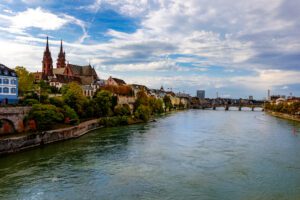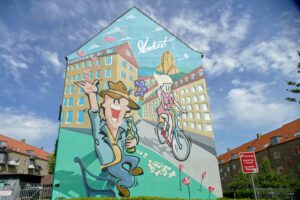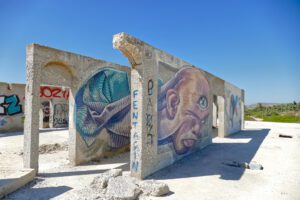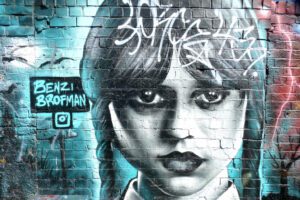The Biennale di Arte, one of the world’s most important art events, takes place every two years. Although Venice is certainly a place worth visiting even when nothing special is on, my post on how to visit the city during the Biennale 2024 will make your trip even more memorable.
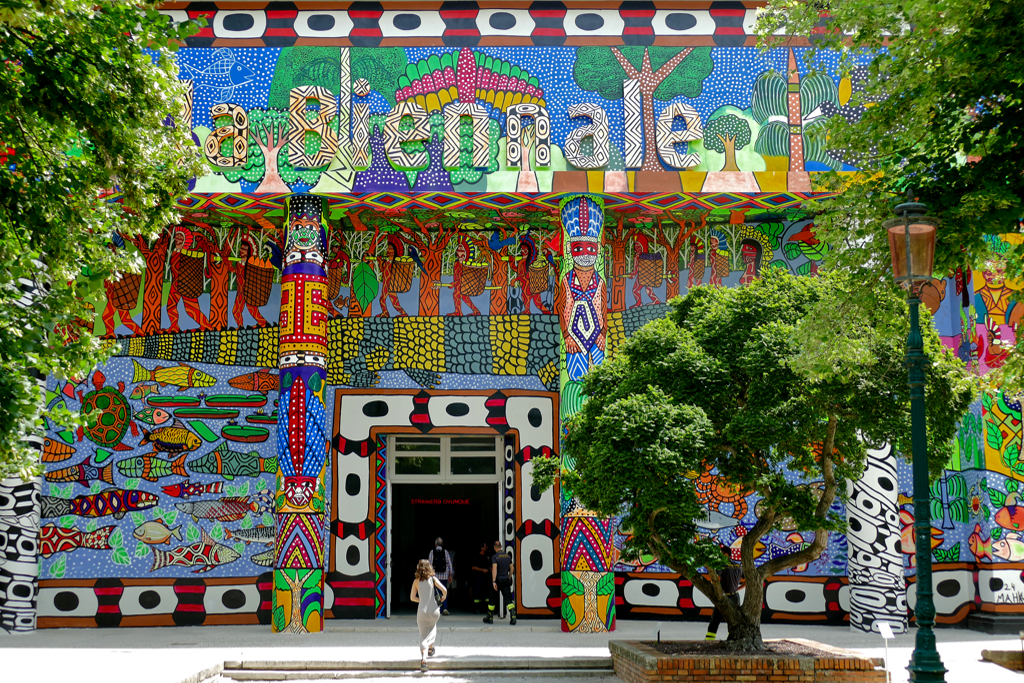
Venice and I: Regular Visits to the Mystic Lagoon City
To me, Venice has always been not only one of Europe’s most beautiful cities, it’s also one of the most unique places on planet Earth. Already the idea of what incredible economic and political power this relatively tiny place built on stilts in the waters used to have for centuries is simply mindblowing. The amazing number of artistic geniuses that were active right here and composed, painted, and sculpted indelible masterpieces with reference to this unique place proves that Venice is somehow magical.

Even large groups of noisy tourists cannot temper my delight when it comes to Venice. When in Venice, I’m far too mesmerized to be annoyed. Also, since I keep coming back every other year, I hardly ever frequent the heavy-duty tourist spots anymore.
Although the city as such is also a valid cause for my frequent visits, for many years now, the main reason has been the mega art event called Biennale di Arte.
The Biennale and I: The Ideal Event for an Art Addict
As the name suggests, the Biennale di Arte has been taking place every other, odd-numbered year. This changed in 2021 as the 59th edition had to be postponed to 2022 due to the pandemic.
Before I visited the Biennale for the first time many years ago, I was a bit intimidated:
Since Venice was so packed already without anything special going on, how terrible must be the crowds during such an outstanding event? Consequently, I armed myself for the worst.
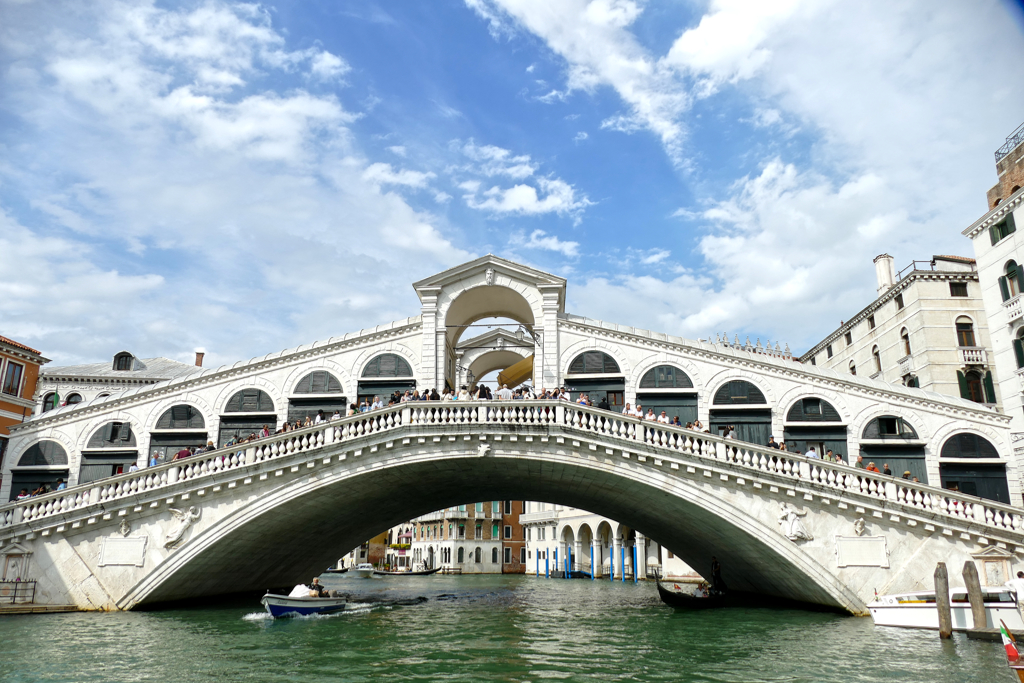
Once I got there, I realized that most tourists still do come for the regular sights’n’landmarks. They visit Saint Mark’s Square and the Rialto Bridge, glide in Gondolas, and purchase tacky masks. Many visitors aren’t even aware that a great art show is taking place. Venice seemed to remain pretty much untouched by this event.
It’s in the Mix
Even if you are just coming to see the city, you’d need weeks to visit it all: Venice has about 30 museums, approximately 200 palazzi, and roughly 90 churches – and we are talking just about the so-called Centro Storico, hence the main fish-shaped part. Now, add around 100 art venues that are temporarily installed during the biennial and you get the picture.
You have to decide what you want to see, you certainly cannot have it all. Therefore, I’m skipping the traditional landmarks and heading for the new and the temporary.

However, even for first-time visitors who are focusing rather on the traditional must-sees, visiting Venice during the Biennale comes with a great perk: Since many parts of the art event are housed in the old palaces, you get access to palazzi that are normally closed to visitors.

For me, however, it’s the mix of it all that catches me in a whirlwind of awe: The iconic sights of the canals and bridges and alleys that never get old. The inspiring art from around the world. Wild’n’daring contemporary pieces are exhibited in front of antique tapestries and under ancient gilded ceilings.
If I could create a world for myself, it would be an everlasting Biennale di Arte in Venice.
Biennale Arte di Venezia
So what exactly is the Biennale di Arte? Well, the Venice biennial dates back to 1893. Then, the city council decided to introduce an exhibition on Italian art – called Esposizione Biennale Artistica Nazionale. The first edition took place in 1895, and since then, every two years.
Over the years, it opened up to other countries. Therefore today, it is an important international art show, officially called L’Esposizione Internazionale d’Arte, La Biennale di Venezia.
Normally, this art show takes place every other year – as the title insinuates. Therefore, every odd year, I was roaming the venues, palaces, and galleries in search of the most inspiring and exciting artworks. Since ironically, 2021 was quite odd on so many levels, the biennial skipped this odd year. Hence, due to the Covid-19 pandemic, since 2022, the Biennale has taken place in the even years.
Mind you, apart from 2021, the biennial had to be revoked only during WWI and WWII which makes the cancellation quite a historical event.
The Giardini And the Arsenale
The Biennale takes primarily place at two large venues. One of them are the Giardini, hence, the gardens, located in the Castello neighborhood.
Here above all, 27 countries have the opportunity to present artists of their choice at their respective national pavilions. The first, by the way, was the Belgian one, constructed in 1907.
In 1980, the art show was extended to another major venue, namely the Arsenale. This arsenal is a massive terrain of former shipyards and armories, located just minutes from the Giardini.

The remaining countries that do not have a steady pavilion in one of these central venues can still exhibit in rented places scattered throughout the city. This way, as I pointed out above, you have access to Palazzi and other stately buildings that normally are not open to the public.
Beyond the country’s contributions, there are themed exhibitions in the central pavilions of both main venues. Those are designed by a curator.
What’s On In 2024
Since the Biennale di Arte is such an important international event, the paintings, sculptures, installations, photos, and videos always had a reference to current social and political topics. In 2015, when the Nigerian Okwui Enwezor, who died in 2019, curated the biennale, the topic of migration took center stage for the first time.
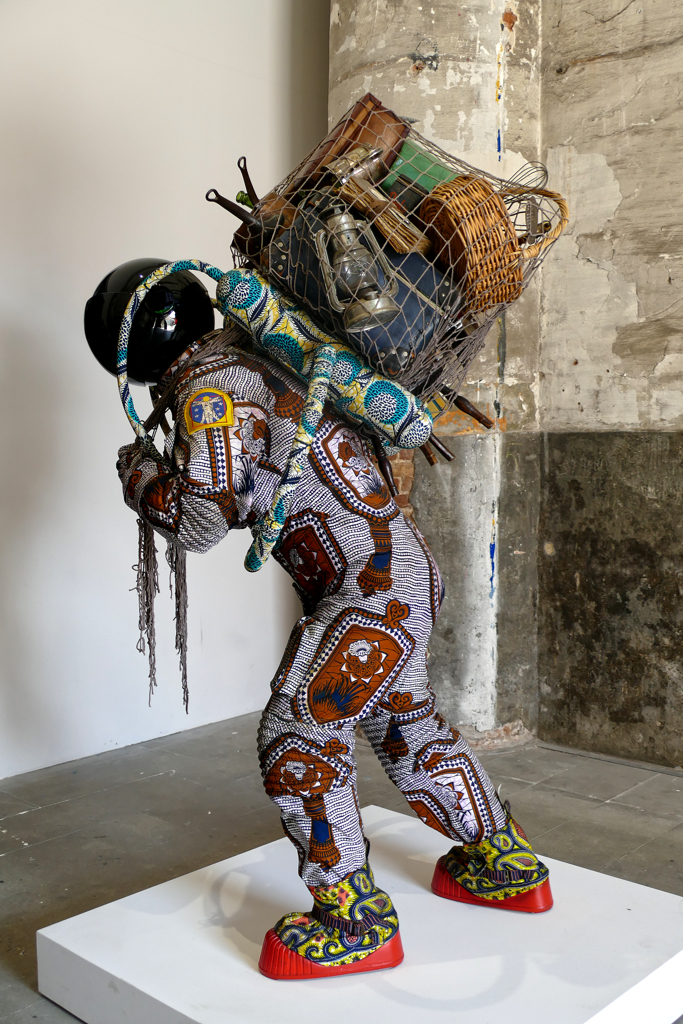
Since then, other themes have been taken into focus, but the topic of uprooting and foreignness in their various effects have remained an integral part. This was implemented particularly impressively at the Biennale 2022, which gave artists belonging to marginalized groups such as the LGBTQ+ community a broad platform.
This year, curator Adriano Pedrosa returns to the movement of peoples and people with his theme Stranieri Ovunque – Foreigners Everywhere. While, with a few exceptions, he does not present any new impulses or inspiring variations in the curated exhibition, some of the participating artists shed light on the topic from different perspectives.
When we talk about migrants, we immediately associate people fleeing countries where there is war or at least great poverty. Hence, I appreciated it all the more that former colonial nations such as the Netherlands, Belgium, and Spain recalled that in the past, foreigners invaded continents not to escape hardship, but to exploit locals and to profiteer. Yes, colonial masters were also Stranieri Ovunque – Foreigners Everywhere, after all.
Shed a Light into Dark Corners
Also, I liked the fact that strangers who are usually overlooked in an artistic context are also put into focus as well as ethnicities who became strangers in their own native countries.

You’ll find outstanding examples at the Australian and Danish pavilions. At the pavilion of the USA, Jeffrey Gibson is the first Native American to represent his home country. Julien Creuzet from Martinique, an island that is absurdly still a French Département, represents France. Speaking of contemporary colonies: The installation The Museum of the Old Colony by Pablo Delano in the central pavilion of the Giardini deals with the ludicrous status of Puerto Rico as a territorial possession of the United States. Acquired in 1898, it is one of the oldest colonies in the modern world.

The war in Ukraine, which has now been going on for more than two years, had already had its effects on the previous edition when the Russian pavilion remained unused. This year again, no artists from Russia took part, but the pavilion did not remain empty. It was simply given to Bolivia.
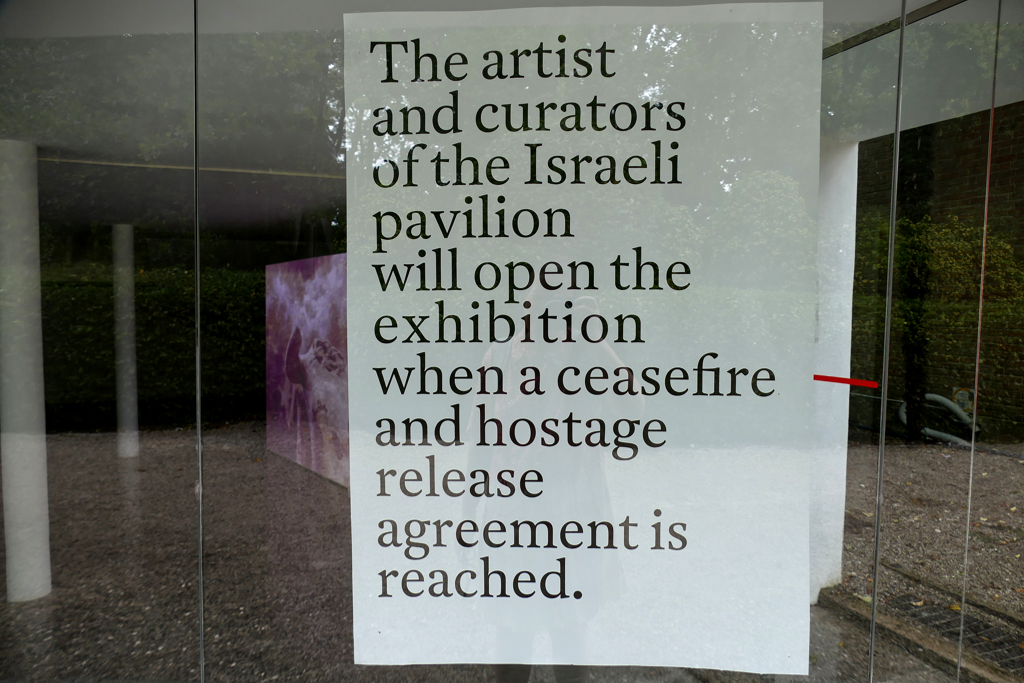
Referring to another armed conflict, Israel was not excluded, but the artist and the curators did put a note on the door saying they would open the exhibition once a ceasefire and hostage release agreement was reached.
The Biennale has been running for months now, and sadly the note is still attached.
Who’s Boss
As I explained above, there is a central, curated exhibition divided between the two main venues. While the participating countries are not bound to a specific topic, the centrally curated part has a motto.
This year, Adriano Pedrosa is in charge of things. He studied law and holds a master’s degree in art and critical writing from the California Institute of the Arts. He is currently the artistic director of the Museu de Arte de São Paulo Assis Chateaubriand in São Paulo. However, during his career, he has curated an impressive number of exhibitions and biennials in his home Brazil but also in many other countries. Naming them all would take up the entire post.
In addition, he has also published articles in numerous art media. Hence, it is no surprise that the Central for Curatorial Studies at Bard College in New York recently awarded him the Audrey Irmas Award for Curatorial Excellence 2023.

In 2019, 83 artists participated in the biennial. Two years ago, the number had almost tripled to 213 participants. And this year, 332 artists partake in this mega-art event!
In addition, there are 87 national participants in the historic Pavilions at the Giardini, at the Arsenale, and in the historic city center of Venice.
My Personal Favorites in 2024
Altogether, I’m coming every two years to Venice to see the Biennale, and it never gets old. In fact, there are far too many unique events and exhibitions in mesmerizing places. In 2024, the event takes place from April, 20 until November, 24. Since this year, I visited quite early, I can gladly supply you with much valuable info and helpful tips on how to visit. Also, just like in 2017 2019, and 2022, I summarized a list of my preferred works from this edition.
Below, I sort 50 works in alphabetical order of the countries. However, you’ll notice that there are only 40 countries on that list. That’s because picking just one contribution from each country was sometimes impossible. For instance, the United States made it quite difficult since this year, not only are they officially represented by the amazing sculptor Jeffrey Gibson. In addition, there is a wonderful collateral exhibition by biennial-veteran James Lee Byars at the Palazzo Loredan.
Oh, sorry, I haven’t explained the so-called Collaterali yet: Apart from the major venues and the country pavilions, there are art exhibitions taking place that are not officially part of the Biennale di Arte. They are rather a very fancy by-catch. I assume they pick the timeframe of the biennial for their shows since they know that enough art buffs will be in town. Hence, for the list below, I also picked various artists that don’t officially represent their country, but show their works at one of the Collaterali.
50 Works from 40 Countries
So anyway, the list below is sorted by country, however, according to my very personal preferences. I’ve added brief info on the work, and also whether it’s part of the curated exhibitions, a country pavilion, or a collateral show. Furthermore, I’ve stated where you’ll find it.
Nevertheless, on the map at this post’s end, you’ll find everything: The main venues, the country pavilions, and the Collaterali, no matter if it’s on my best of list or not. Also, you’ll get all the relevant info to make your visit to the Biennale 2024 unforgettable.
- Angola
- Argentina
- Armenia
- Azerbaijan
- Belgium
- Bulgaria
- Chile
- China
- Croatia
- Cuba
- Denmark
- Estonia
- Great Britain
- India
- Iran
- Italy
- Ivory Coast
- Lebanon
- Macao
- Mexico
- Morocco
- Netherlands
- New Zealand
- Peru
- Philippines
- Poland
- Puerto Rico
- Qatar
- Romania
- Saudi Arabia
- Senegal
- Serbia
- Spain
- Switzerland
- Uganda
- Ukraine
- United States Of America
- Uzbekistan
- Venice
- Zimbabwe
Angola
Kiluanji Kia Henda: The Geometric Ballad of Fear
Kiluanji Kia Henda is showing three works at the Biennale that have a common topic, namely grids. Although they were created over a period of seven years, they are closely linked. The image series Ballad of Fear consists of nine photographs that show white-painted metal guardrails in front of buildings in Angola.
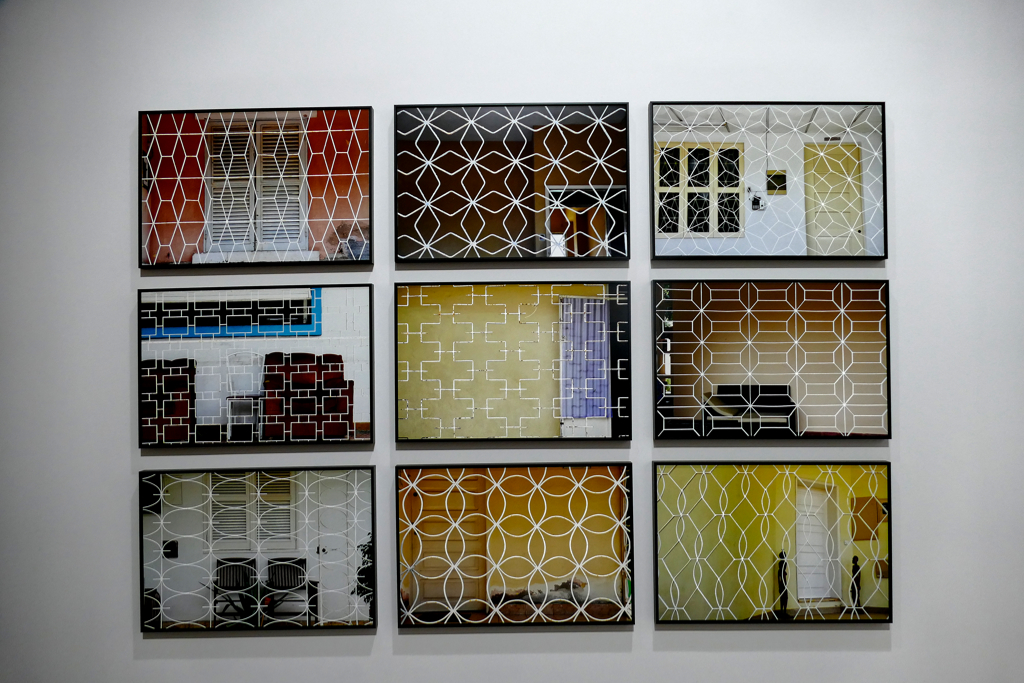
For travellers, seeing protective barriers outside private homes in major cities in the Global South with significant income disparities is a familiar sight. They represent the economic imbalance in society and therefore do not symbolize anything good. In contrast, in the artist’s photos, they demonstrate graphic harmony.
Venue: Central Pavilion at the Arsenale.
Argentina
Chiachio & Giannone
The Swiss watch manufacturer Swatch has sponsored the biennial for years. One of their activities is the Swatch Art Peace Hotel which grants outstanding artists residency. At the Swatch Faces 2024 exhibition, six former artists in residence from the Swatch Art Peace Hotel are presenting their creations, and Chiachio & Giannone are two of them.
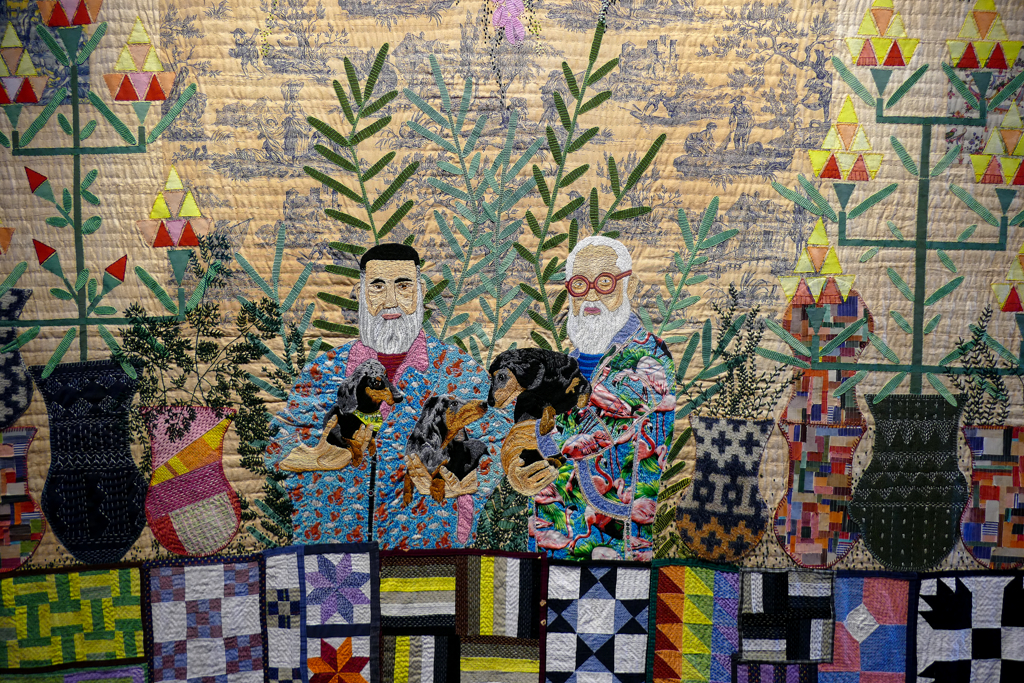
Leo Chiachio and Daniel Giannone are a gay artist collective from Argentina.
Since 2003, they have been creating works of art together primarily using textiles and fabric-based embroidery, occasionally supplemented by gouache painting.

As a gay art collective, Chiachio & Giannone have undertaken several LGBT+ projects that advocate for the community. Often, community members donate a piece of fabric with an encouraging message, which the artists then incorporate into a larger project.
Venue: Sale d’armi, Arsenale
La Chola Poblete
The Argentinian artist La Chola Poblete works with painting, objects, photography, video, and performance.

The artist critically examines the consequences of colonialism and white supremacy in her home country. She uses traditional ornaments as well as queer imagery. La Chola Poblete’s large-format watercolors show the fluidity that results from her identity.
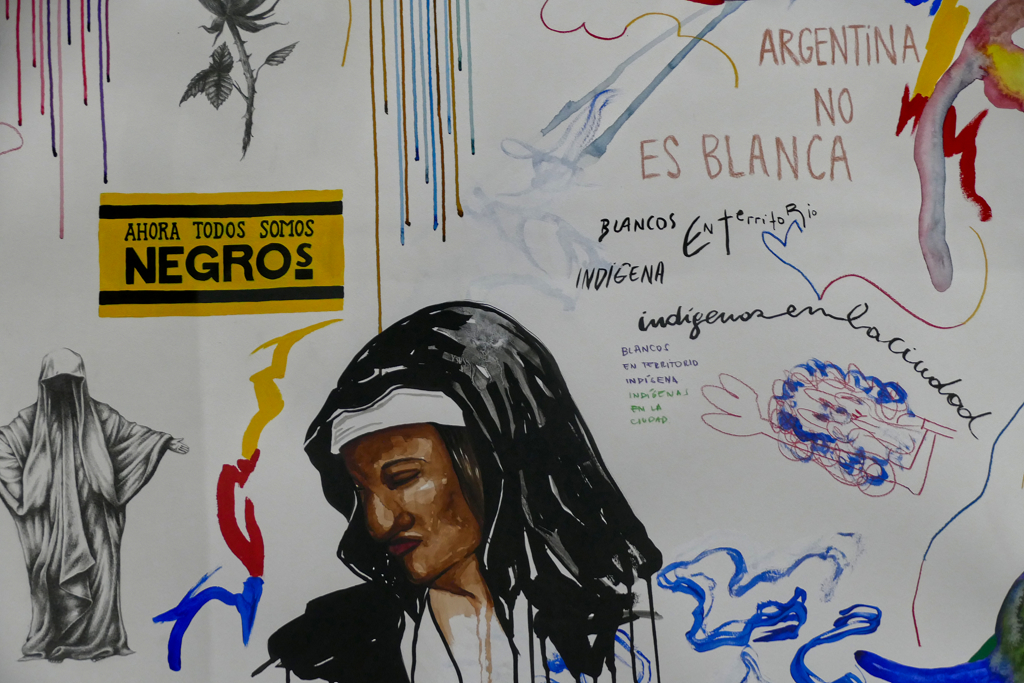
La Chola Poblete was named Artist of the Year by Deutsche Bank in 2023.
Venue: Central Pavilion at the Arsenale.
Armenia
AKNEYE
AKNEYE is an Armenian art project. Although it is not an official part of the Biennale, the exhibition rooms are located opposite the Arsenale main entrance.

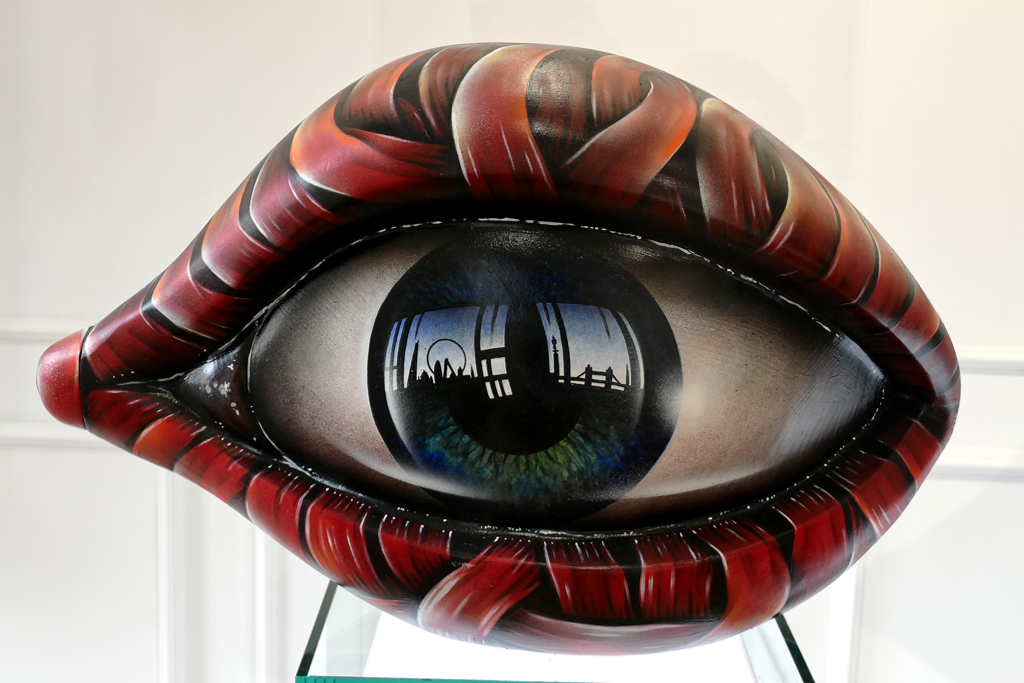
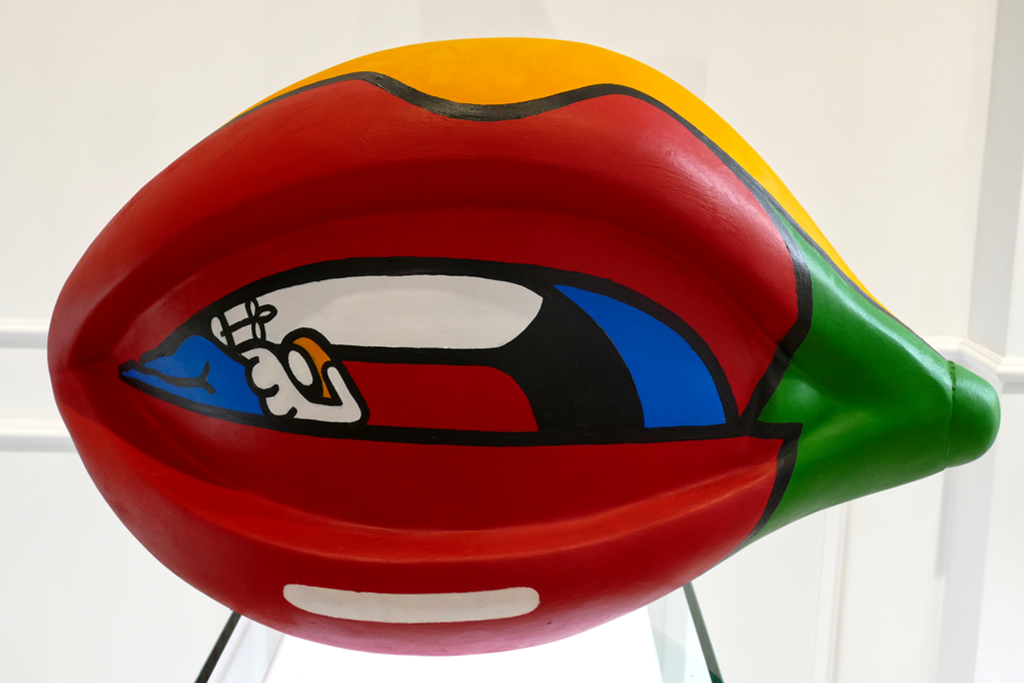

A collection of works by different artists is on display. The project creates a variety of unique works and enables artists from all over the world to express their vision. Presented with a raw canvas in the shape of an eye, artists are invited to create the eye sculpture in their own way. Selected artists create their eye in a live performance in the exhibition rooms in Venice. Hence, keep your eyes open so you don’t miss this exhibition.
Venue: Ramo della Tana , Castello 2124/A
Azerbaijan
Various Artists: From Caspian to Pink Planet – I Am Here
Ever since I have been coming to the Biennale, Azerbaijan has always stood out with some unique works. In particular, Rashad Alakbarov’s sculptures in 2015 have remained unforgettable for me. Back then, he played with perspective by arranging a bunch of metal objects so that only their shadows on the wall created a writing. Very alluring.
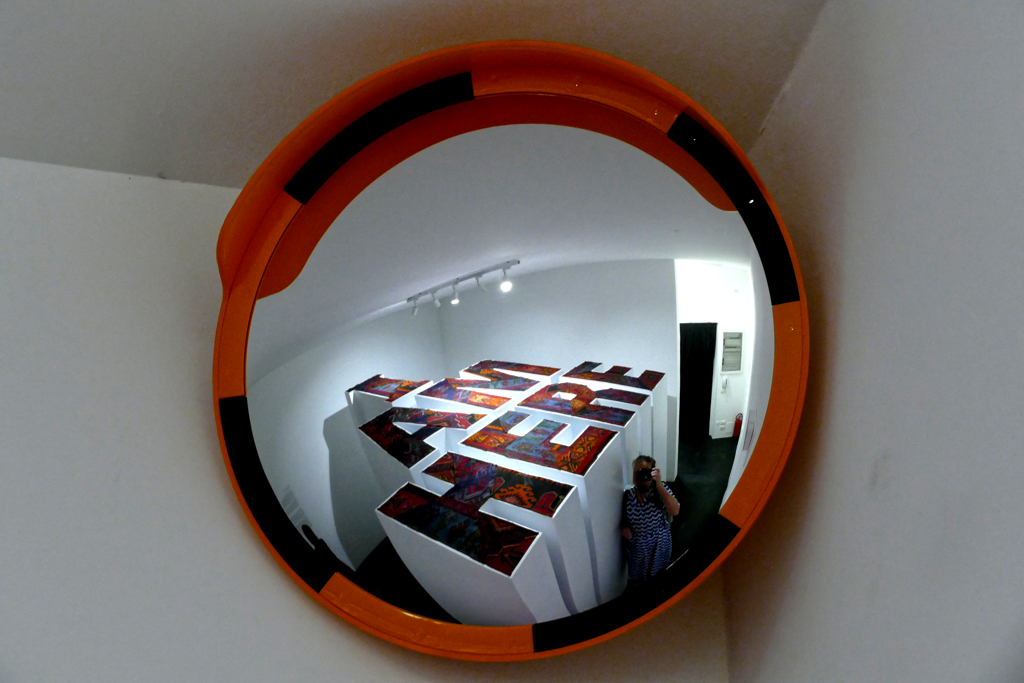
Alakbarov, who is one of three Azerbaijani participants, is also playing with the viewer’s perspective in 2024. While walking among tall white objects, you feel a little lost. Only in a mirror can you see that these are actually tall letters that form the sentence I Am Here. Basically, a new interpretation of the saying can’t see the wood for the trees.
Venue: Pavilion of Azerbaijan, Campo della Tana, Castello 2126/A
Belgium
Various Artists: Petticoat Government
Artwise, Belgium simply never disappoints. This year, in contrast to a completed work, the Belgian Pavilion is merely a transit point for the performance Petticoat Government.
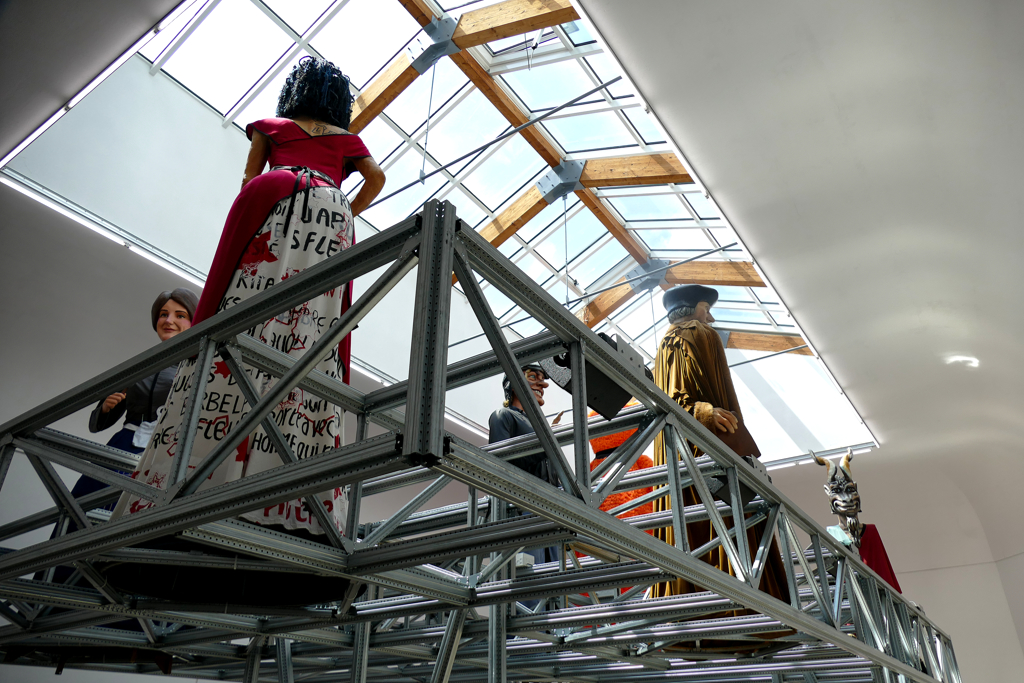
It presents a multidisciplinary scenario and uses traditional folkloric figures from Belgium, France, and Spain. The project travelled to Italy in March 2024 and will return to Charleroi and Dunkirk in 2025. The artist collective mixes visual and performing art, architecture, and typography, thereby breaking the traditional exhibition format.
Venue: Belgian Pavilion at the Giardini
Berlinde De Bruyckere: City of Refuge III
Berlinde De Bruyckere was born in the Belgian city of Ghent and is one of the artists who demand the most from their audience. Her sculptures made from old and worn organic materials such as fabric, resin, wax, but also fur and even animal skins are certainly not for every art lover and can be extremely disturbing. It is of little comfort that the artist claims to prove that nothing disappears or ends, but only changes.
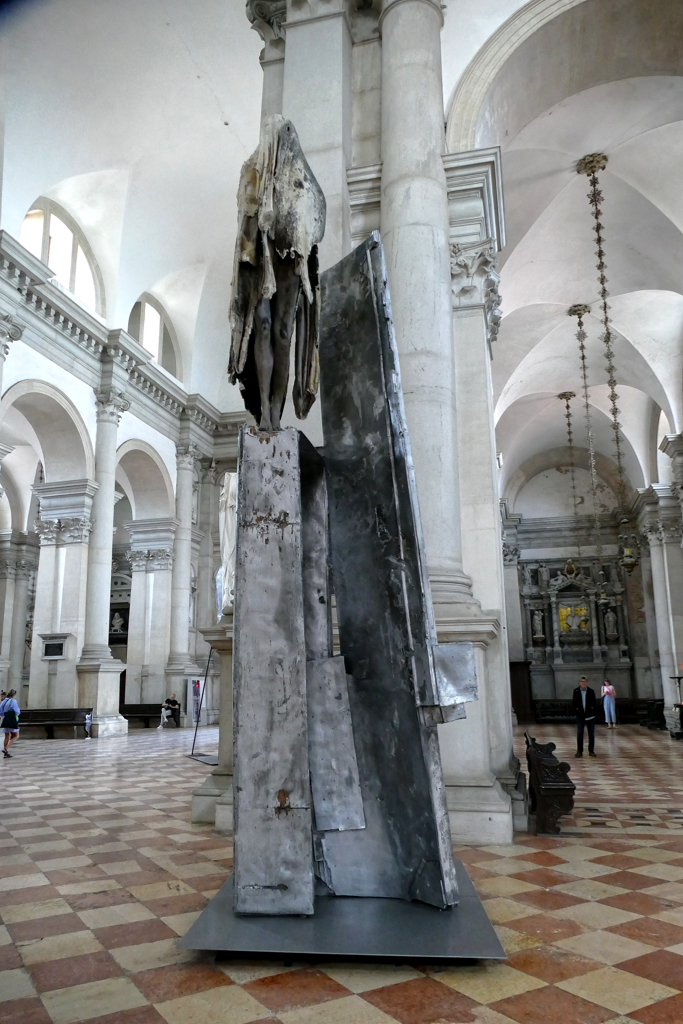

City of Refuge III is the third part of a series of exhibitions. The sculptures made from worn, ambiguously identifiable materials appear as if they are decaying and rotting before your very eyes. The unsettling appearance is taken to another level by the spiritual intensity of the church.
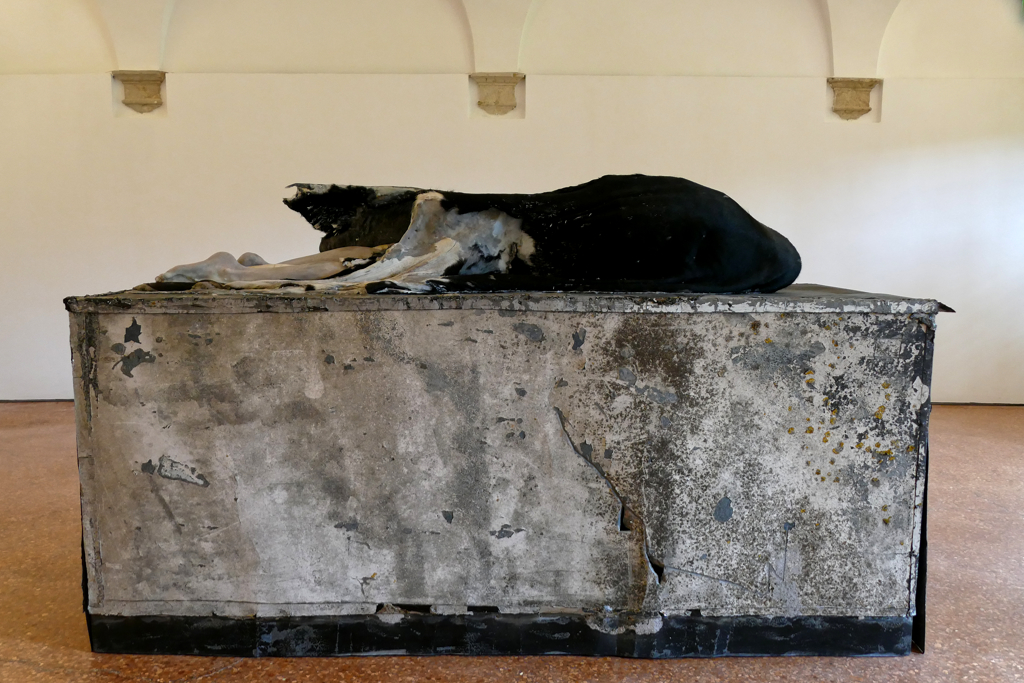
Venue: Abbazia di San Giorgio Maggiore
Bulgaria
Various Artists: The Neighbors
The installation sheds light on the memories of survivors of political violence during Bulgaria’s communist era. Using film and sound recordings as well as everyday objects, people report on their trauma in forced labor camps and prisons. The fact that it was the ordinary people from – literally – next door who were arrested and tortured and disappeared for years is symbolized by the installation in a simply furnished apartment consisting of a living room, bedroom, and kitchen. It makes The Neighbours a poignant memorial to recent southeastern European history.
Venue: Sala Tiziano-Centro Culturale Don Orione Artigianelli, Fondamenta delle Zattere ai Gesuati 919
Chile
Unidentified Chilean Artists: Arpilleras
Arpilleras are the iconic textile artifacts created during Augusto Pinochet’s military dictatorship in Chile. They are named after the Spanish term for burlap sacks. They seem like cute little quilts, but are a silent accusation and reminder of the many who disappeared in the resistance against the military dictatorship.
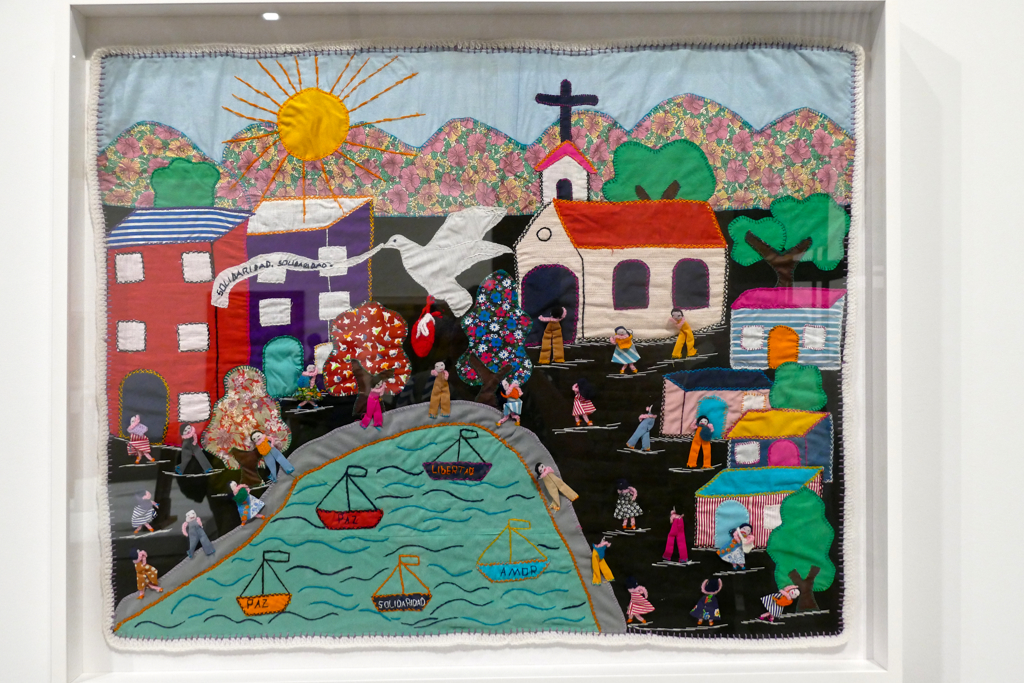
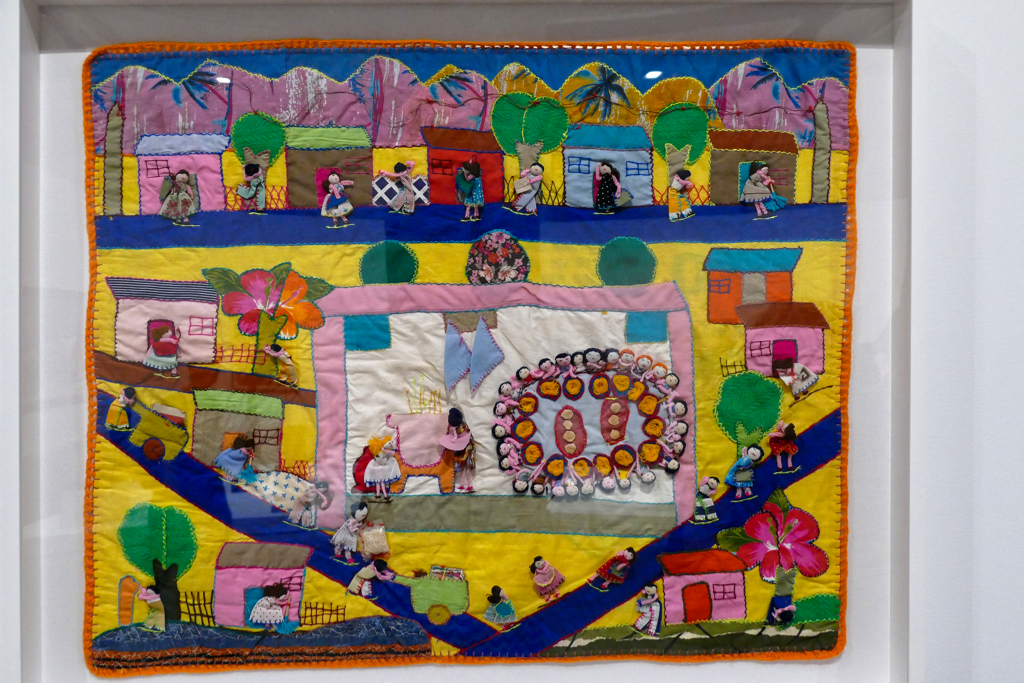
The works shown at Biennale Arte are part of a collection of over 200 pieces at El Museo del Barrio in New York. The Arpilleras are telling us about the struggles for institutional change in the South American nation, which is still governed by the constitution imposed by the Pinochet regime. However, the bright sun on each Arpillera is a sign of hope and belief in change.
Venue: Central Pavilion at the Arsenale.
China
Various Artists: Atlas – Harmony in Diversity
In the exhibition in the pavilion of the People’s Republic of China, seven contemporary artists took the cultural heritage of their homeland into focus.
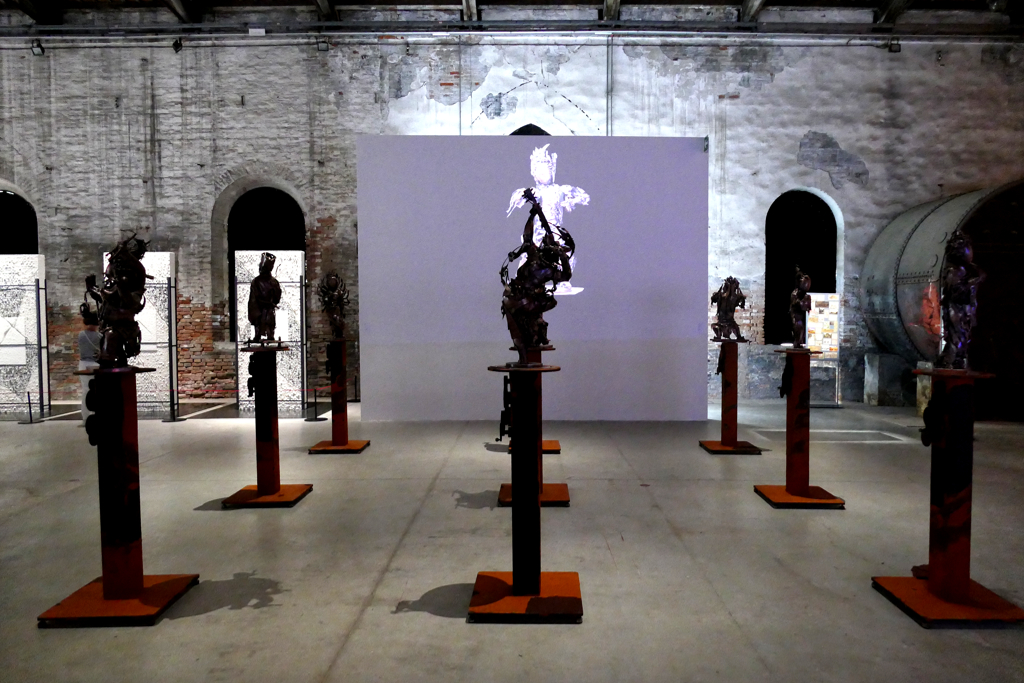
They created works based on literature, considering various aspects such as architecture, landscapes, figures, flowers, and birds. They are treading the path from the legacy of the traditional to the contemporary and thus renewing it.
Venue: Chinese Pavilion at the Arsenale
Yu Hong: Another One Bites the Dust
Yu Hong is one of China’s most influential painters. The exhibition in the Romanesque-Byzantine Church Chiesetta della Misericordia, founded by Augustinian monks in the 10th century, features narrative paintings that show the path of all flesh from birth to death.

The human experiences of birth, fear, desire, sex, and death are mostly expressed through the pain undergone by women in contorted positions.

Venue: Chiesetta della Misericordia, Cannaregio
Croatia
Vlatka Horvat: By the Means at Hand
I like Vlatka Horvat’s conceptual project for the Croatian pavilion. It is a comprehensive, dynamic work consisting of many contributions from international artists. What they have in common is living as foreigners in different countries. Horvats invited them to share and exchange their experiences through various works of art. The project is therefore based on the principles of friendship and solidarity, thus, the foundations for being able to live and thrive on foreign soil.
Venue: Fàbrica 33, Calle Larga dei Boteri, Cannaregio 5063
Cuba
Wilfredo Prieto García: Curtain
I really like it when art challenges my viewing habits. I always find it fascinating to observe how my eye adapts to external circumstances and how adaptable it is. Cuban artist Wilfredo Prieto García’s work Curtain is such a challenge. At first, you almost feel lost in a pitch-dark room. And as the eye gets used to the darkness and you see more and more of the entire space, the illuminated stone even seems to change in size.

By the way, the exhibition does not rely on this personal perceptual experience, but rather has a very wordy philosophical background. Fortunately, it is up to each individual to experience and interpret art.
Venue: Teatro Fondamenta Nove, Cannaregio 5013
Denmark
Inuuteq Storch: Rise of the Sunken Sun
When I praised contributions in the introduction that shed light on other aspects of foreignness, I was referring, among other things, to the exhibition by the photographer Inuuteq Storch.
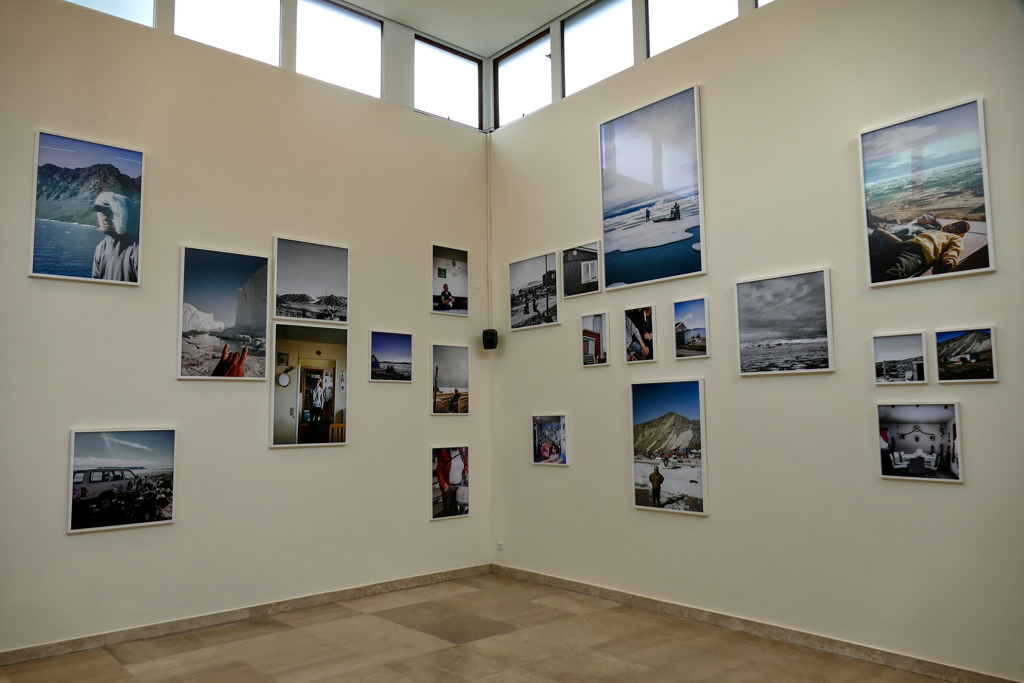
With his camera, he explores and documents various aspects of his homeland Greenland. Greenland is the world’s largest island and yet, it is an autonomous territory of the small Kingdom of Denmark. Therefore, this time, quite logically, Kalaallit Nunaat is written on the Danish pavilion. This is Greenland’s proper name in the local language and is translated as the Land of the Kalaallit.
Venue: Danish Pavilion at the Giardini
Estonia
Edith Karlson: Hora Lupi
Estonia is another country whose contribution I look forward to each year. Estonians have a thing for weird art. This year, Edith Karlson focuses on the exploration of human impulses in her installation in the church of Santa Maria delle Penitenti.
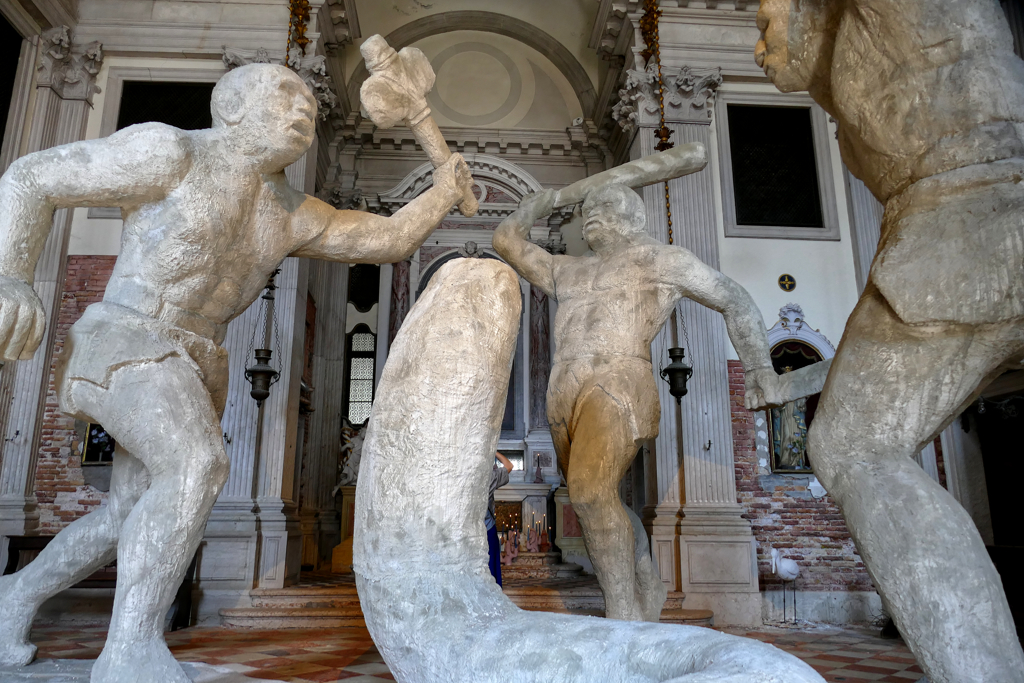
In Karlson’s work, in addition to humans, we see human-animal hybrids, grieving women and bright white storks, reminiscent of the inevitable misfortune of birth and the ever-striving nature of man. This way, an existential narrative emerges in the church showing the animal nature of man as sometimes brutal and violent and other times in its poetic, gentle, and melancholic form.

One of Edith Karlson’s storks is also part of the highly recommended current Glasstress exhibition, which I present below.
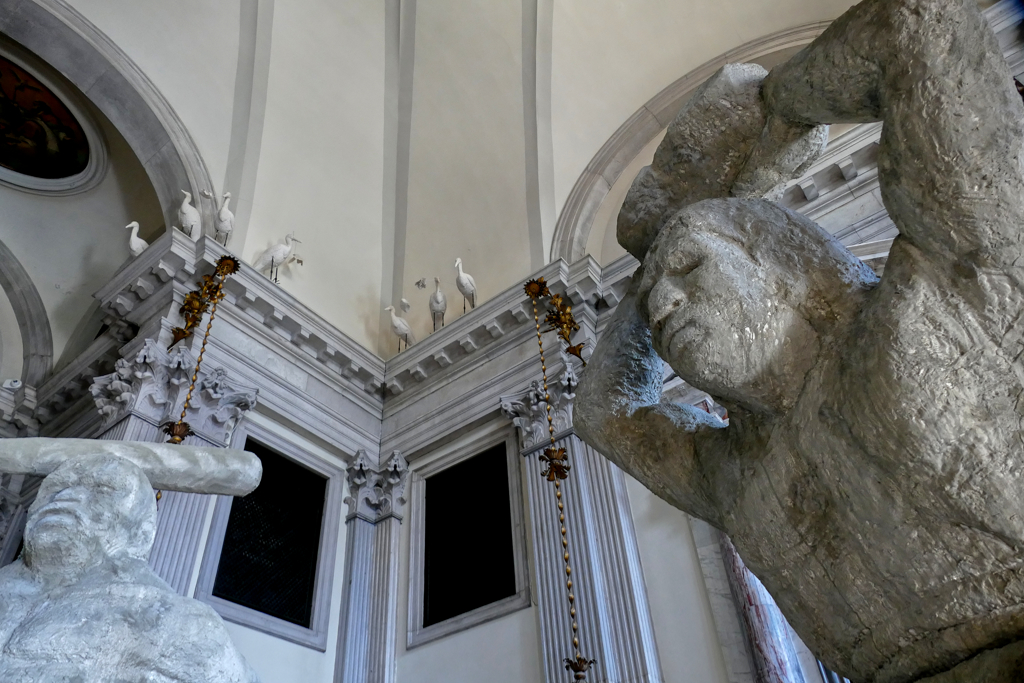
Venue: Chiesa delle Penitenti, Fondamenta Cannaregio 890
Great Britain
John Akomfrah: Listening All Night to the Rain
I myself would prefer to introduce John Akomfrah as a Ghanaian artist because he was born in Accra. But since he lived in England most of his life, he is now featured in this section. Actually, this brings us right to the topic of his video installation in the British Pavilion.
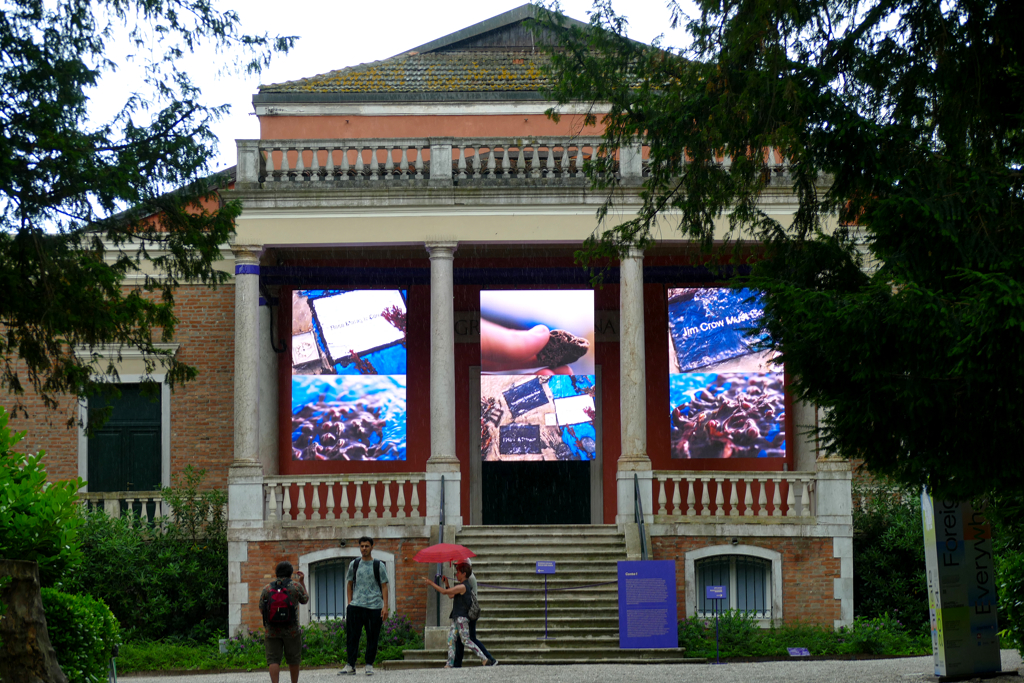
In Listening All Night To The Rain, he deals with political topics such as post-colonialism and the ecological issues associated with it, among other things. The installation consists of eight interlocking video works where water is a central motif that connects the different visual and acoustic parts.
Venue: British Pavilion at the Giardini
Osman Yousefzada: Welcome! A Palazzo for Immigrants
The solo exhibition of the interdisciplinary artist Osman Yousefzada was created in collaboration with the Victoria & Albert Museum in London and is presented by the Fondazione Berengo. Welcome! A Palazzo for Immigrants addresses topics of unity and migration in modern society.
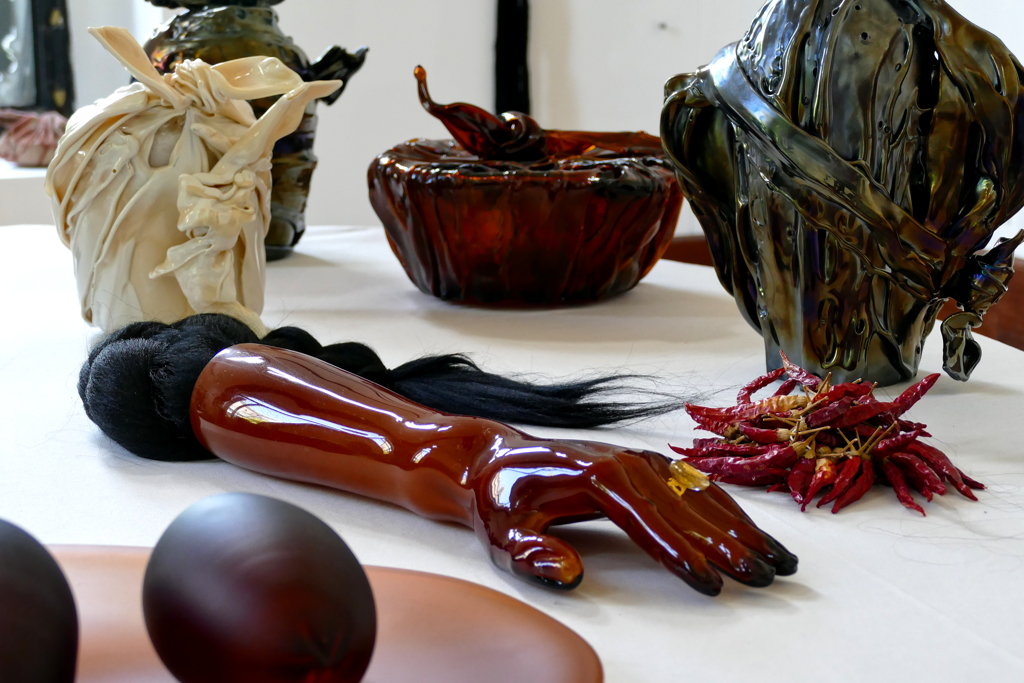
Yousefzada creates a touching setting with prints, sculptures, videos, and handmade textile works. This is where tradition and modernity, roots and uprooting meet. Many of the central objects in the installation have components made of hand-blown Murano glass, with which the artist builds a bridge from his own roots to the lagoon city.
This collateral ends on October 7th, hence, before the official end of the Biennale.
Venue: Palazzo Franchetti, San Marco 2847
India
Cosmic Garden
This Collaterale celebrates the beauty of India’s cultural heritage with paintings and sculptures by Madhvi Parekh and Manu Parekh. It was created in collaboration with Chanakya School of Craft, a Mumbai-based nonprofit organization that aims to empower women through crafts.
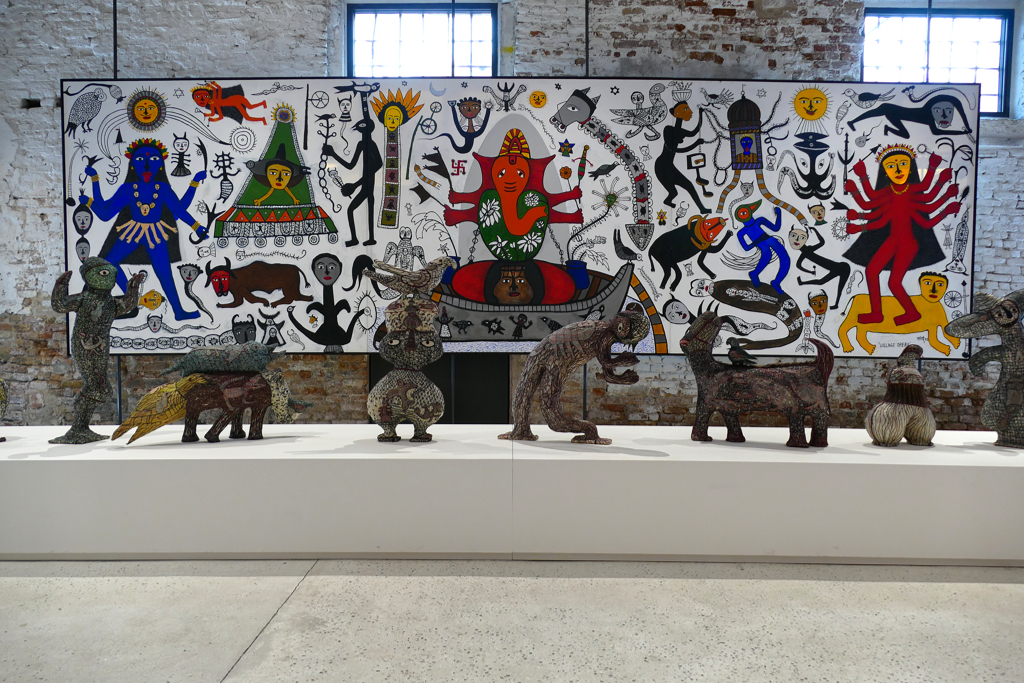
This carefully curated series of works takes a multidisciplinary approach and breaks the hierarchies between art genres.
Venue: Salone Verde – Art & Social Club, Calle della Regina 2258
Aravani Art Project
Aravani Art Project is a collective made up of cisgender and transgender women. Their mural, featured in the Arsenale’s curated pavilion, depicts trans bodies as a natural part of life.
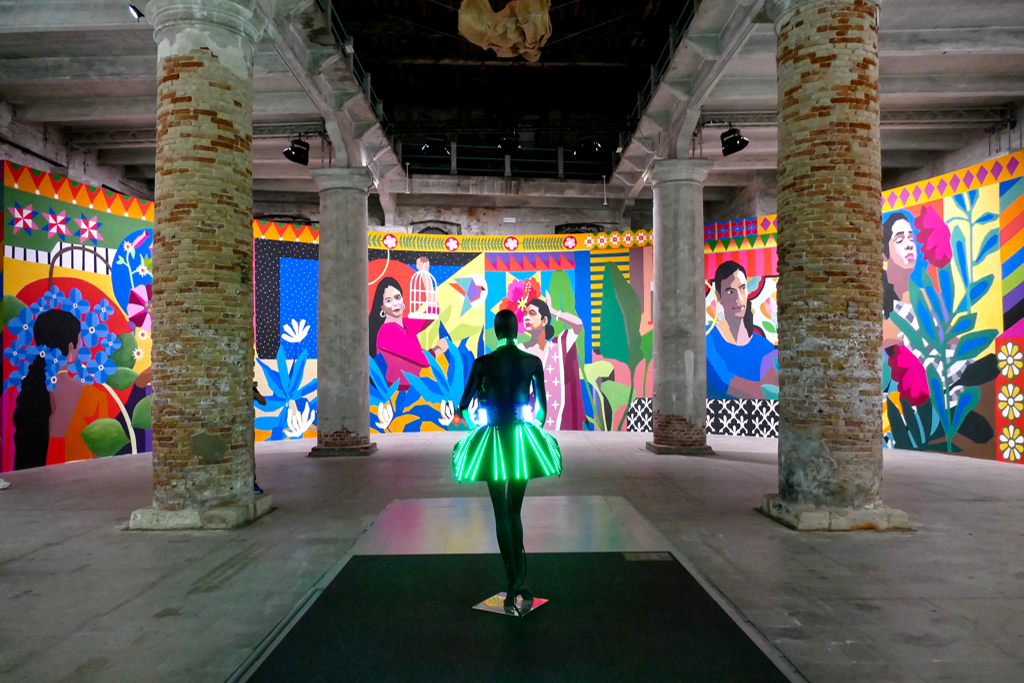
Designed in bright colors and with multi-faceted details, the depictions represent very different opportunities that trans people should be granted. This makes color a crucial and meaningful element of the group’s work.
Venue: Central Pavilion at the Arsenale.
Iran
Reza Aramesh: Number 207
The Iranian-born artist Reza Aramesh is exhibiting the part Number 207 of his sculpture series in the Church of San Fantin, an approximately 1,000-year-old building.

It consists of three prisoner statues and 207 pieces of men’s underwear made from Carrara marble. These modest garments become symbols of the loss of what is closest and most intimate. They represent the loss of personality and identity in places of dehumanization through imprisonment.
The pieces on display were inspired by archive images and war reports from the 20th and 21st centuries.
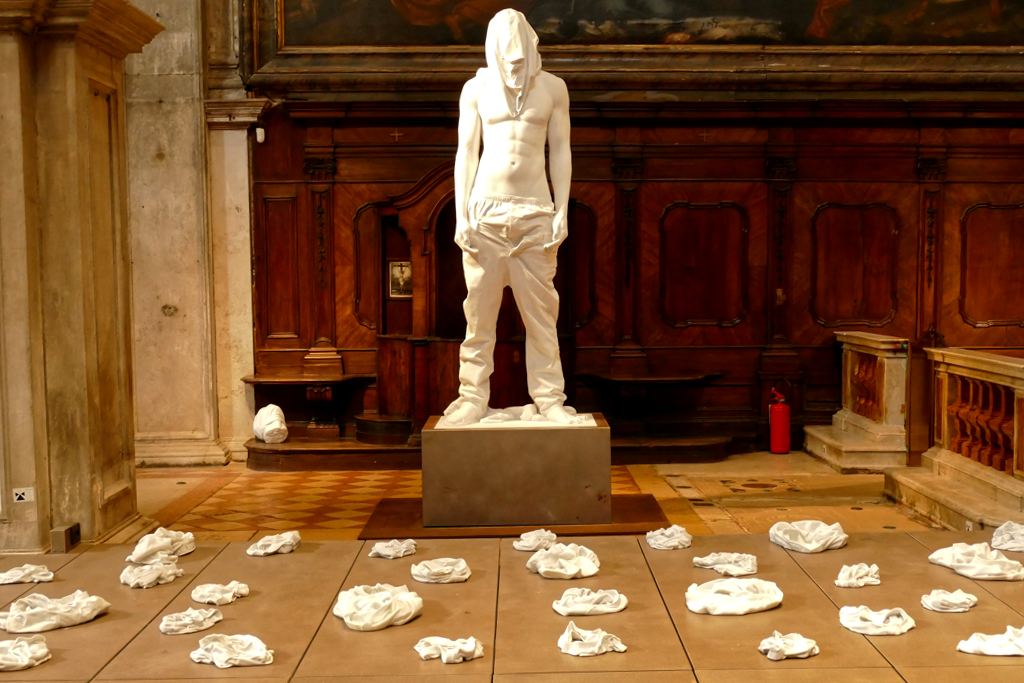
The reaction of visitors to this exhibition was also interesting. While the artist doesn’t actually stylize or embellish anything in his depiction, it still seems aesthetically pleasing. Two young women were thrilled by the attractive photo opportunity while an Asian couple giggled embarrassedly at the sight of their underwear. The appealing visuals seem to have placed a gentle veil over the actual horror.
Venue: Chiesa di San Fantin. San Marco 1965
Italy
Giulia Andreani: The Cutting and Sewing School
I love Giulia Andreani’s paintings. They’re like faded photographs found in an old shoebox in the far corner of the attic. And in fact, Andreani only uses the color Payne’s Gray for her often melancholic pictures.
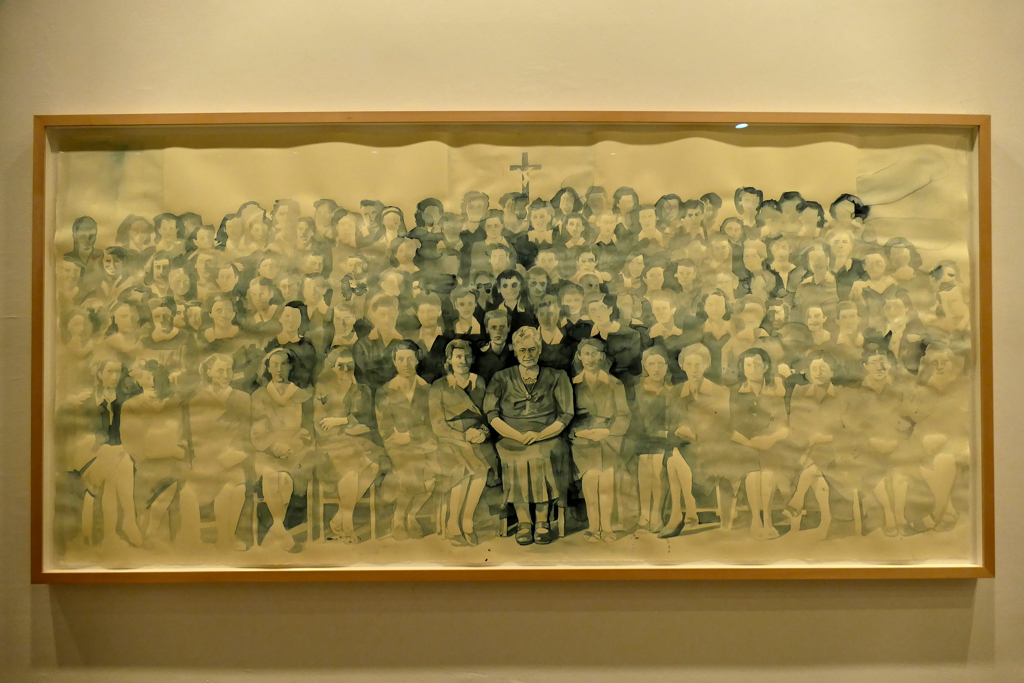
Giulia Andreani was born in Venice in 1985. Today she lives in Paris. In her art, the artist has focused on history painting, where she tends to portray everyday heroes. In their slightly blurry hyperrealism, they are sometimes reminiscent of the family portraits of the German artist Gerhard Richter.
Venue: Central Pavilion at the Giardini.
Ivory Coast
Various Artists: The Blue Note
It’s about black identity. It’s about pan-Africanism. The common language is art, but more often music.
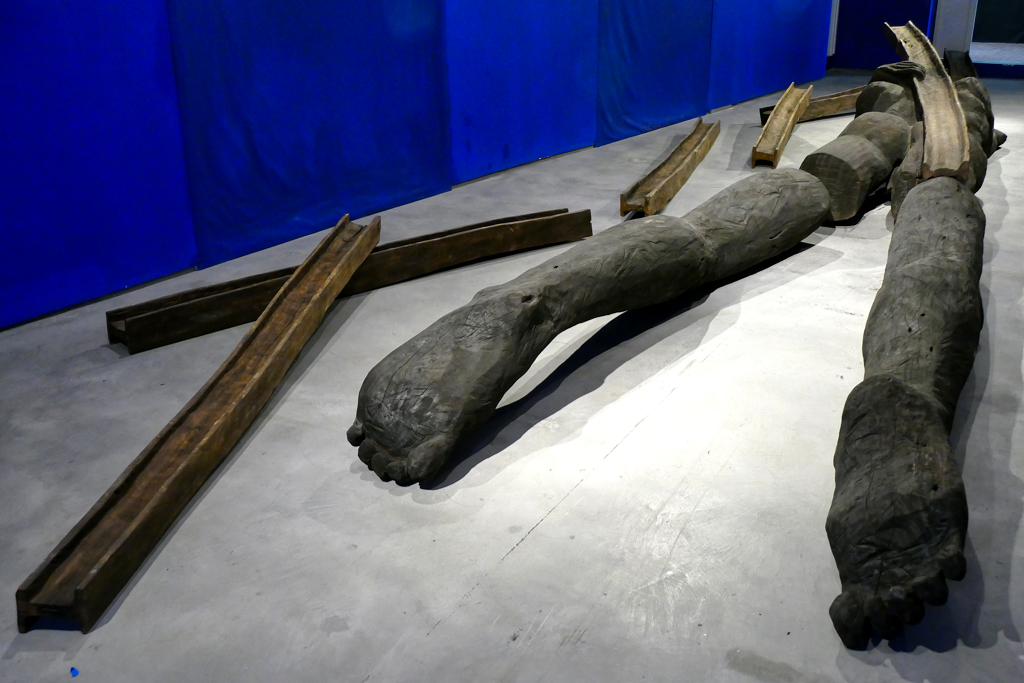
The blues that the descendants of Africans deported to the USA feel and translate into music. Among other powerful works, the main room of the Ivory Coast pavilion is designed as a mysterious yet atmospheric jazz club.
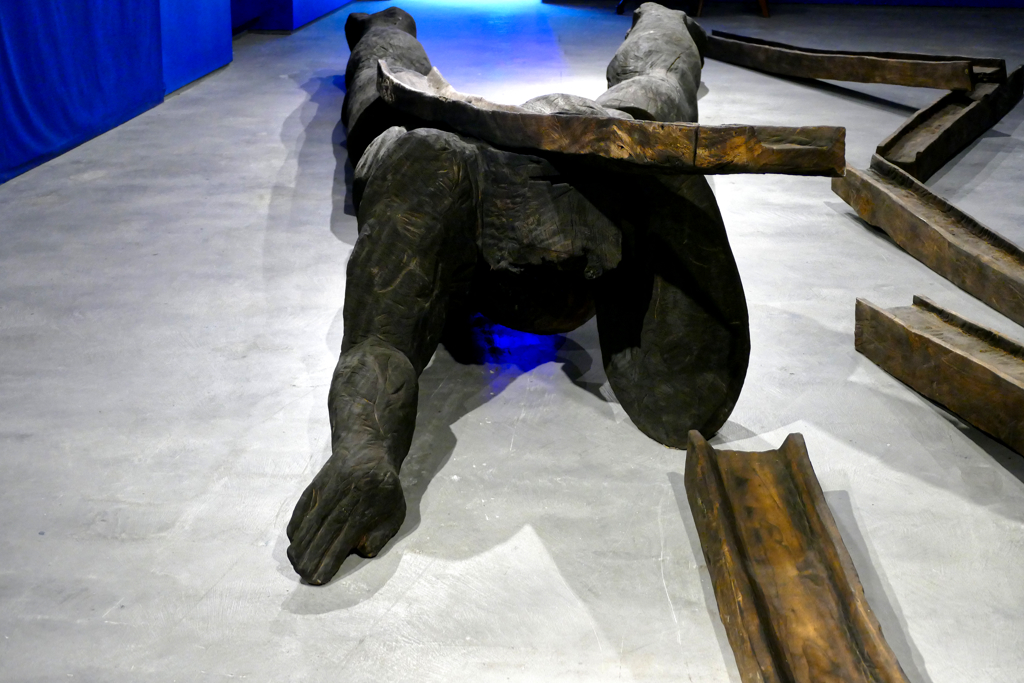
Venue: Centro Culturale Don Orione Artigianelli – Dorsoduro 947
Lebanon
Omar Mismar: Mosaics
Omar Mismar lives and works in Beirut. This is astonishing because the motifs of his beautifully crafted mosaics are extremely provocative – especially by Middle Eastern standards.

The first thing that caught my eye was Two Unidentified Lovers in a Mirror, which shows two half-naked men kissing. An explicit picture of queer life that is unlikely to be met with much enthusiasm in Lebanon. Although the other motives are not so obvious, they are still provocative by reducing hero worship to absurdity and denouncing hardships.
Venue: Central Pavilion at the Arsenale.
Macao
Wong Weng Cheong: Above Zobeide
Another rather disturbing installation comes from Wong Weng Cheong. His work is inspired by a fictional city in a novel by Italian writer Italo Calvino. In the gloomy, dimly lit exhibition room, a grassland with deformed rabbits and sheep awaits.
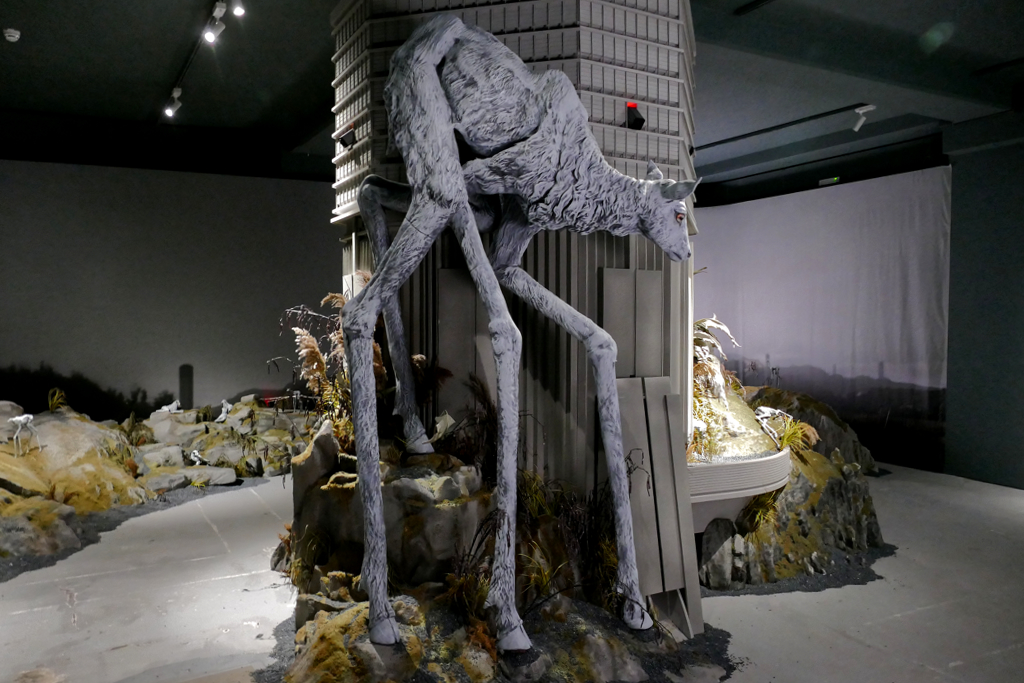
The sheep with their spindly legs are a particularly recurring motif. However, this trademark quickly evokes unpleasant feelings as it makes the creatures appear deformed and degenerated, as if after a nuclear accident.
Venue: Istituto Santa Maria della Pietà, Calle della Pietà, Castello 3701
Mexico
Erick Meyenberg: As we marched away, we were always coming back…
Erick Meyenberg is a Mexican artist of German and Lebanese descent and designed the Mexican pavilion. In the center, there is a table framed by large screens.
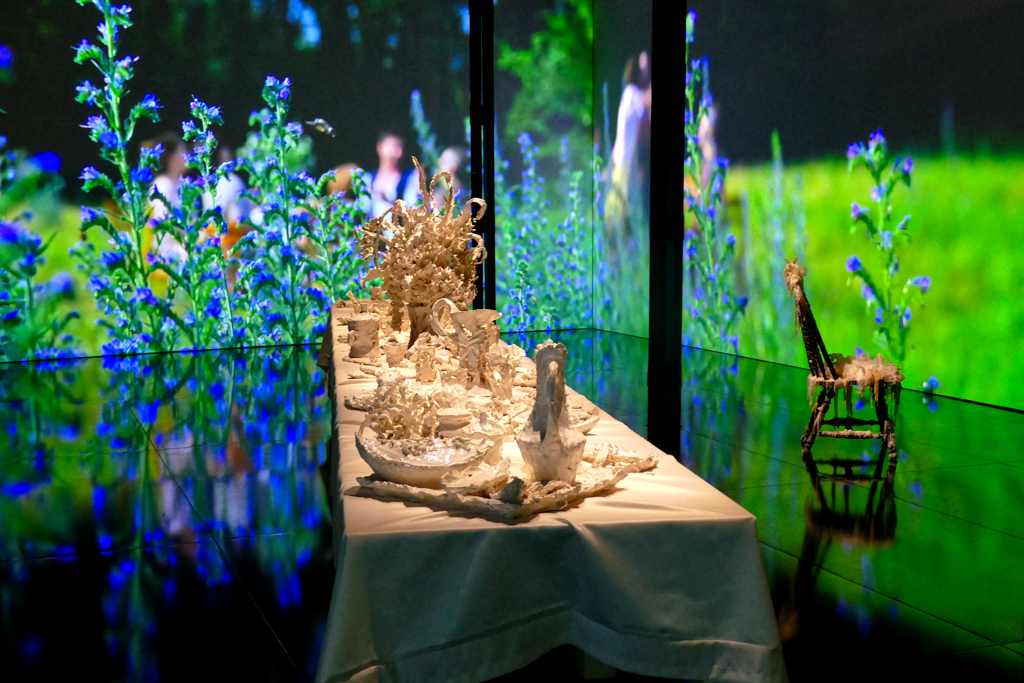
In 2019, Meyenberg brought together the Doda family, who had emigrated to Italy from Albania. You can see their reunion on the screens. The setting poetically represents the uprooting through emigration and at the same time the rootedness that a mutual family lunch can signify.
Venue: Pavilion of Mexico at the Arsenale
Betsabeé Romero: The Endless Spiral
Betsabeé Romero is a visual artist from Mexico City. She creates graphics, sculptures, installations, photographs, and videos. Her works have been shown in more than 40 solo exhibitions in America, Africa, Asia, and Europe.
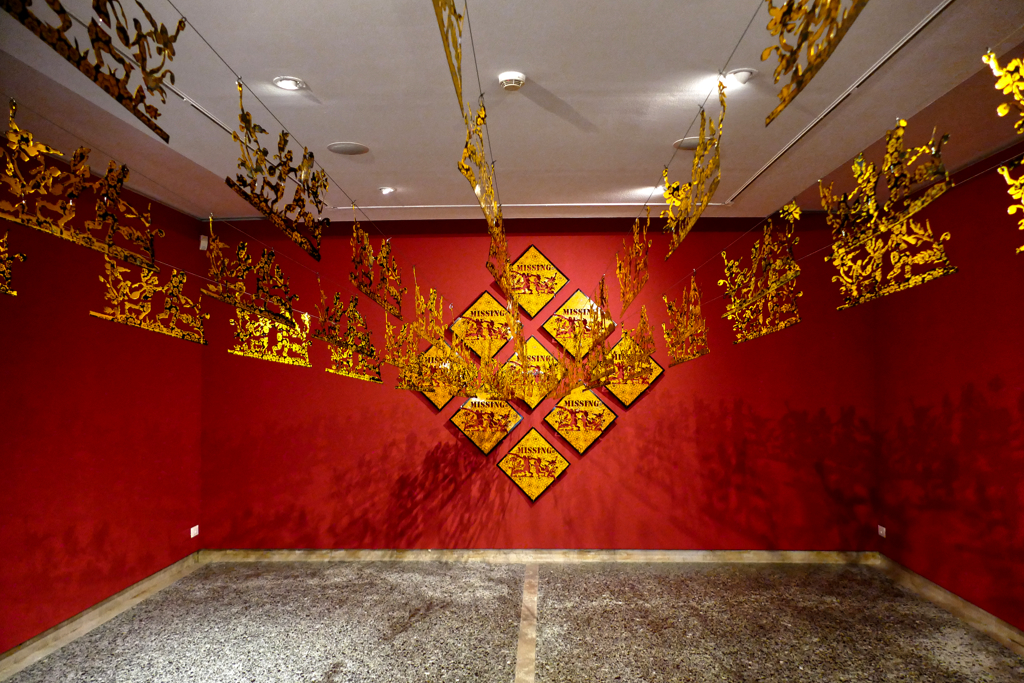
As part of the Biennale, she reflects on borderlines in her exhibition called The Endless Spiral.
This is not just about boundaries between territories, but also about edges and sharp lines that violate personal, communal, cultural, and historical identity.
The artist takes those into focus who search and flee and repeatedly clash with political and economic boundaries.
Venue: Istituzione Fondazione Bevilacqua La Masa, San Marco
Morocco
Bouchra Khalili: The Mapping Journey Project
The Mapping Journey Project is an installation in which eight people sketch on large screens the routes they have had to take due to political and economic circumstances. The artist met her protagonists by chance at traffic junctions in Europe, North Africa, and the Middle East. They told her about their odyssey, which they traced on a map with a Sharpie.
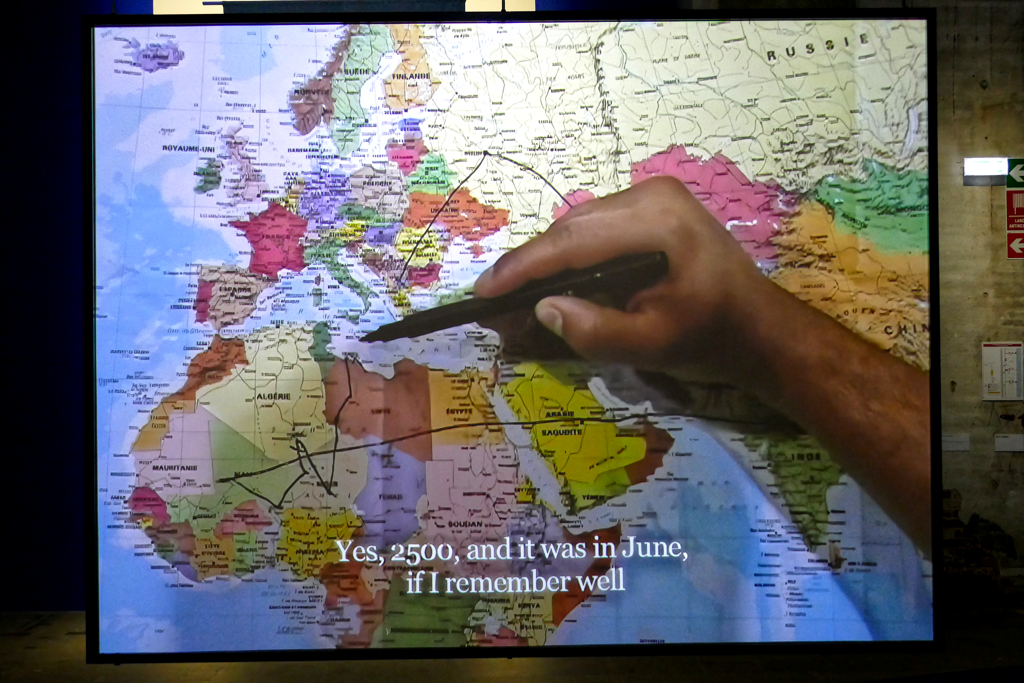
You hear the protagonists’ voices and see their hands, but their faces stay hidden.
On the one hand, they remain protected in anonymity, but on the other hand, they stand as examples for the many other people who have to endure the same hardships.
Venue: Central Pavilion at the Arsenale
Netherlands
Various Artists: The International Celebration of Blasphemy and The Sacred
Cercle d’Art des Travailleurs de Plantation Congolaise, or CATPC for short, is an artist collective of Congolese plantation workers based in Lusanga in the Democratic Republic of Congo, which works with the Dutch artist Renzo Martens.
The headquarters is on a former plantation of the British-Dutch company Unilever. Since 2014, CATPC has been buying back their ancestral lands using revenue from their artwork to transform them into species-rich agricultural forests.
During the Biennale, CATPC will present new sculptures in both the Dutch Pavilion and the White Cube in Lusanga.

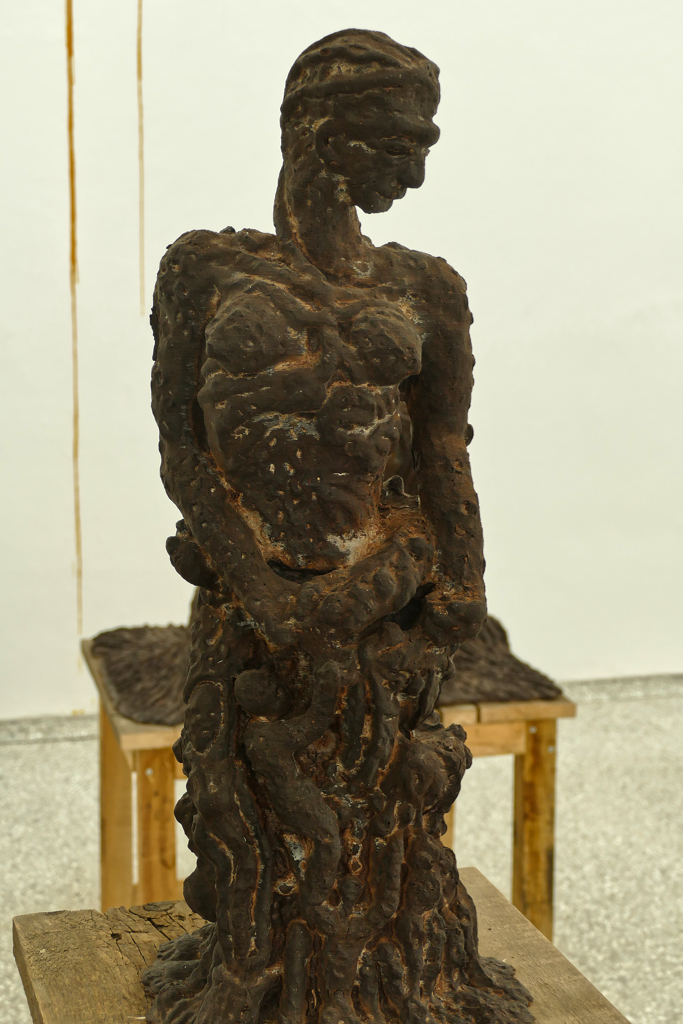
If you smell a subtle note of cocoa when you enter the pavilion, your senses won’t deceive you: all the sculptures are made from cocoa, one of the products for which corporations like Unilever particularly mercilessly exploit the countries where it is produced.
Venue: Pavilion of The Netherlands at the Giardini
New Zealand
Brett Graham: Wastelands
Brett Graham is part of the contemporary Māori art movement. His sculpture Wastelands depicts a carved pātaka, a storehouse where Māori traditionally store food and valuables. Graham’s pātaka, however, is covered with eels.
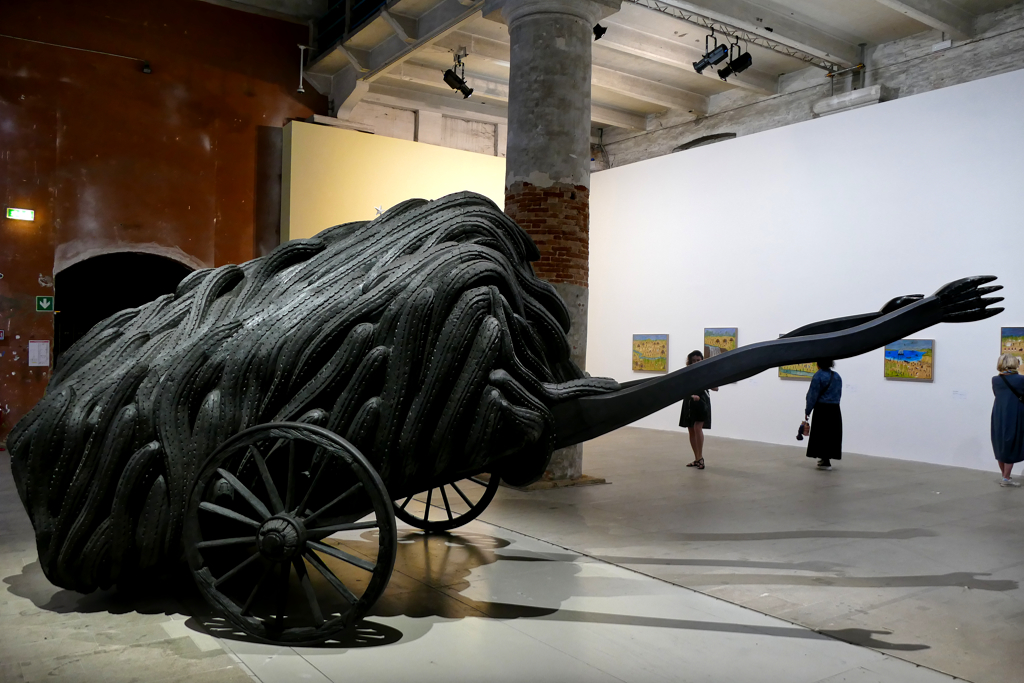
With his sculpture, Graham is denouncing New Zealand’s Waste Lands Act, under which huge swamps were drained and declared uninhabitable, causing the Māori to lose their fishing grounds for eels.
Venue: Central Pavilion at the Arsenale
Peru
Santiago Yahuarcani
Santiago Yahuarcani is a self-taught painter and sculptor belonging to the Aimeni tribe in the northern Amazon region of Peru. In his detailed, complex paintings, Yahuarcanis brings together the traditions, myths, and knowledge of his ancestors.
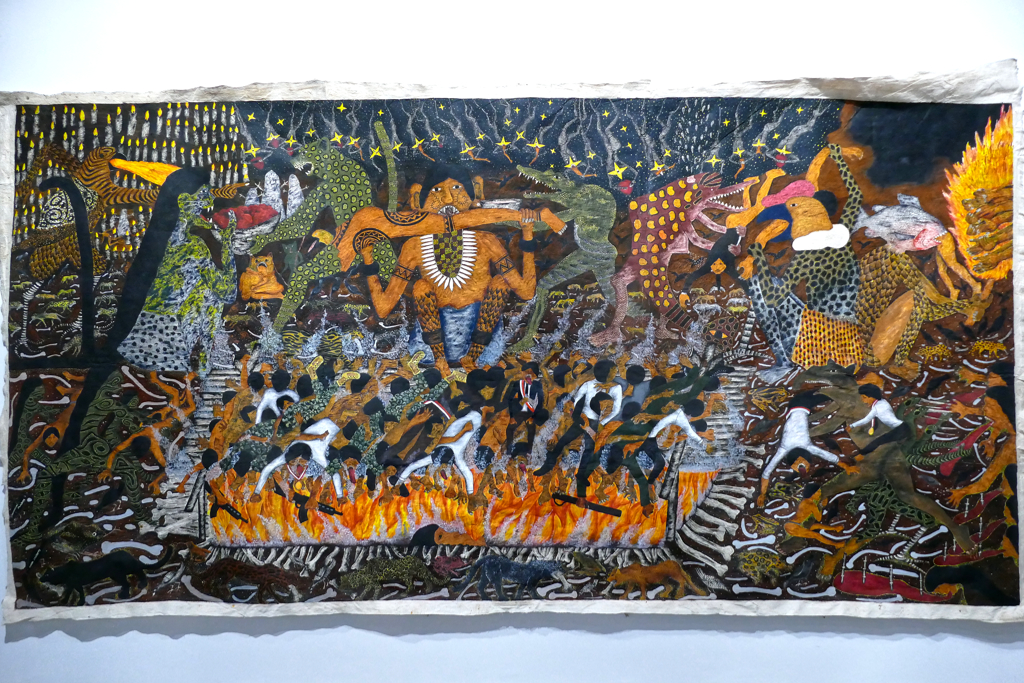
The artist does not get stuck in the past, but creates a dialogue with the present. He emphasizes that the climate catastrophe is part of the colonial expropriation that began with the eradication of traditions and spiritual worlds.
Venue: Central Pavilion at the Arsenale
Philippines
Mark Salvatus: Waiting Just Behind The Curtain Of This Age
Mark Salvatus presents an installation consisting of textile and fiberglass stone sculptures as well as video projections in the pavilion of his home country.

The artist explores the ethnoecology of Mount Banahaw. The mystical liveliness of the mountain is brought to life through the staging of sound, light, and stone sculptures.
Venue: Pavilion of the Philippines at the Arsenale
Poland
Various Participants, curated by Marta Czyż: Repeat After Me II
Repeat after Me II portrays witnesses of the war in Ukraine. These war refugees describe the sound of firearms and then invite the audience to repeat the sound.

It is a karaoke format that consists of deadly shots, rockets roaring, and explosions. The soundtrack of a war.
Venue: Polish Pavilion at the Giardini
Ewa Juszkiewicz: Locks with Leaves and Swelling Buds
Once again, Poland is one of the countries that has made it impossible to select just one entry. In addition to the wonderful exhibition in the Polish pavilion, fantastic paintings by Ewa Juszkiewicz are on display in Palazzo Cavanis.
In Locks With Leaves And Swelling Buds, Juszkiewicz demonstrates a completely new type of portraiture in which hair, scarves, and plants obscure faces.
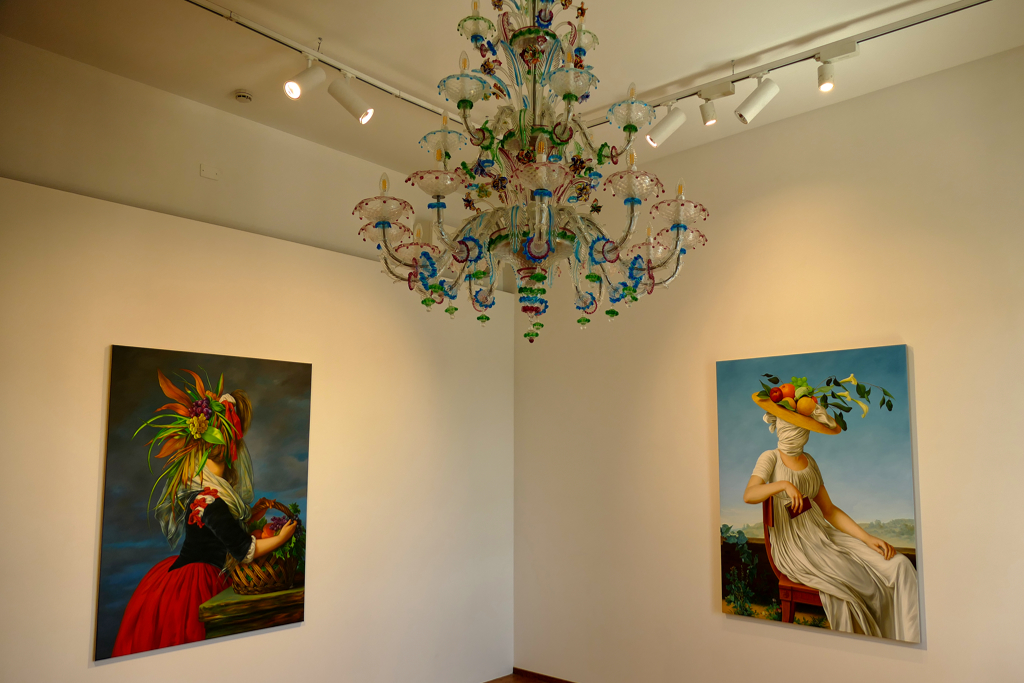
Although all portraits are officially untitled, the artist references well-known paintings, and if you look closely, you can actually recognize the works that inspired her.
Venue: Palazzo Cavanis, Dorsoduro 920
Puerto Rico
Pablo Delano: The Museum of the Old Colony
I know that Puerto Rico is not an independent country – and that is precisely the theme of the installation I am presenting here. Therefore, it would have been a bit tone-deaf to attribute it to the United States.
The Museum of the Old Colony is an ongoing, conceptual installation by Puerto Rican-born artist Pablo Delano. In his work, he deals with the eventful history of his homeland, which was confiscated by the USA after the Spanish-American War of 1898. Delano addresses the relationship between imperial power and the island state and the devastating consequences of colonial rule.
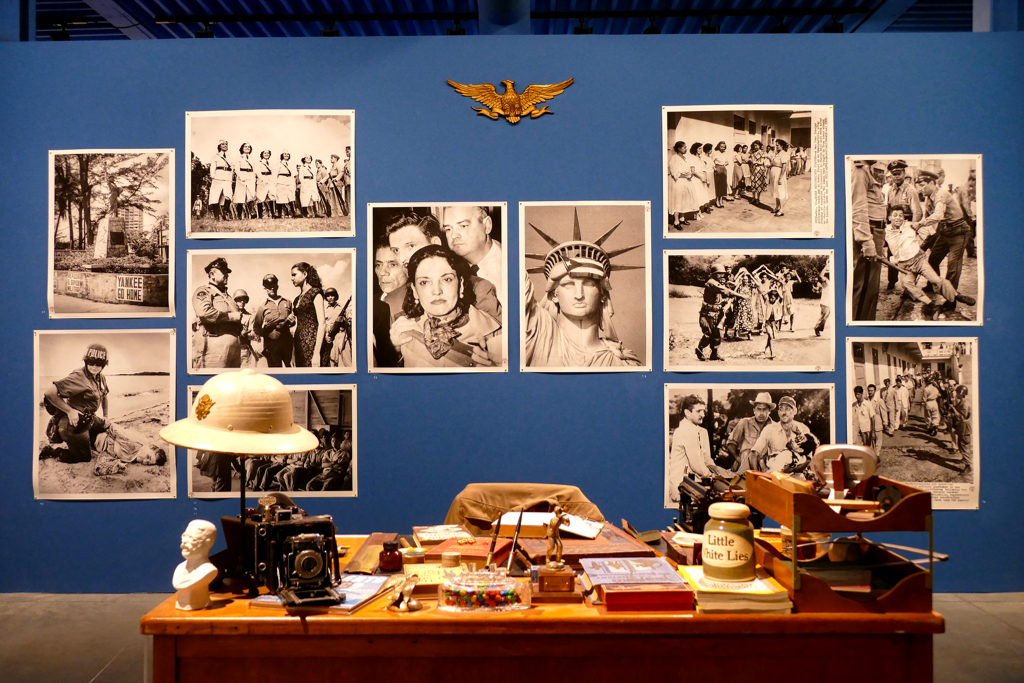
In his installation, Delano criticizes clichés and stereotypes of Puerto Rico through photos, film material, and popular artifacts.
The Museum of the Old Colony is a constantly evolving installation that has been shown in museums in North and South America as well as on several Caribbean islands before the Biennale.
Venue: Central Pavilion at the Giardini
Qatar
Various Artists: Your Ghosts Are Mine
First of all, the Palazzo Franchetti as such is worth the visit and since often, there is an admittance fee, you should take advantage of the fact that a visit during this biennial is free.
I usually hate it when art festivals show videos. Not because I hate films per se. But there’s always so much to see, anyway, that I don’t have the peace and quiet to watch a video longer than, say, five minutes.
However, some of the films shown as part of Your Ghosts Are Mine are so intriguing that they managed to captivate even me and keep me on the spot for longer than usual.
The exhibition Your Ghosts Are Mine includes excerpts from more than 40 films by Arab and African filmmakers. The works come from the collections of Mathaf, the Arab Museum of Contemporary Art, the Doha Film Institute, and the upcoming Art Mill Museum, expected to open in 2030.
The show is a great way to discover works that don’t reach the mainstream. They enable different perspectives – both literally and figuratively – and are therefore absolutely worth seeing.
Venue: Palazzo Franchetti, San Marco 2847
Romania
Șerban Savu: What Work Is
I should perhaps start by saying that I am a big fan of realistic and hyper-realistic painting, and this often includes the works of socialist realism. That’s why I was already impressed by the aesthetics of the Romanian pavilion, even if initially independent of the content and message.
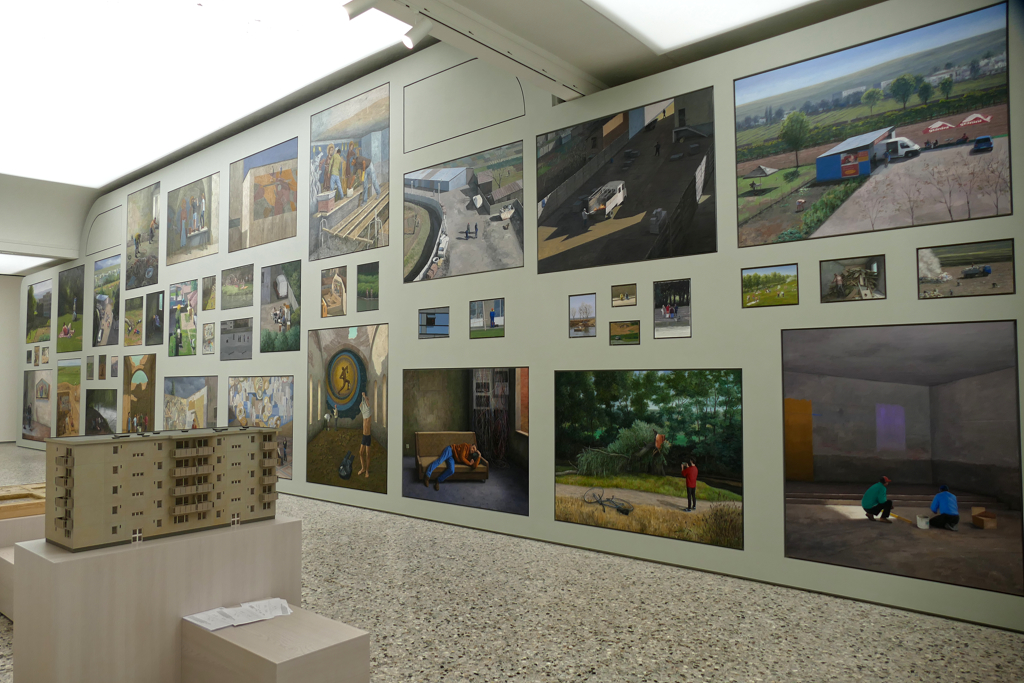
Șerban Savus has arranged 40 paintings here that capture everyday life and the world of work, thus becoming a multi-layered study of a social scene.
Venue: Romanian Pavilion at the Giardini
Saudi Arabia
Manal AlDowayan: Shifting Sands – A Battle Song
Shifting Sands: A Battle Song challenges visitors to move through a maze of large-scale printed silk elements. Some of the elements are printed with texts about Saudi women.

In a series of participatory workshops, the artist offered women and girls a platform to write about themselves and thus determine the narrative for themselves – to shift the sands, so to speak.
Venue: Saudi Arabian Pavilion at the Arsenale
Senegal
Alioune Diagne: Bokk – Bounds
Amazingly, this is Senegal’s first-ever official participation in the Biennale. The artist, who was born in Senegal, depicts scenes of daily life and the major challenges in Senegal in his 4 times 12-meter painting.
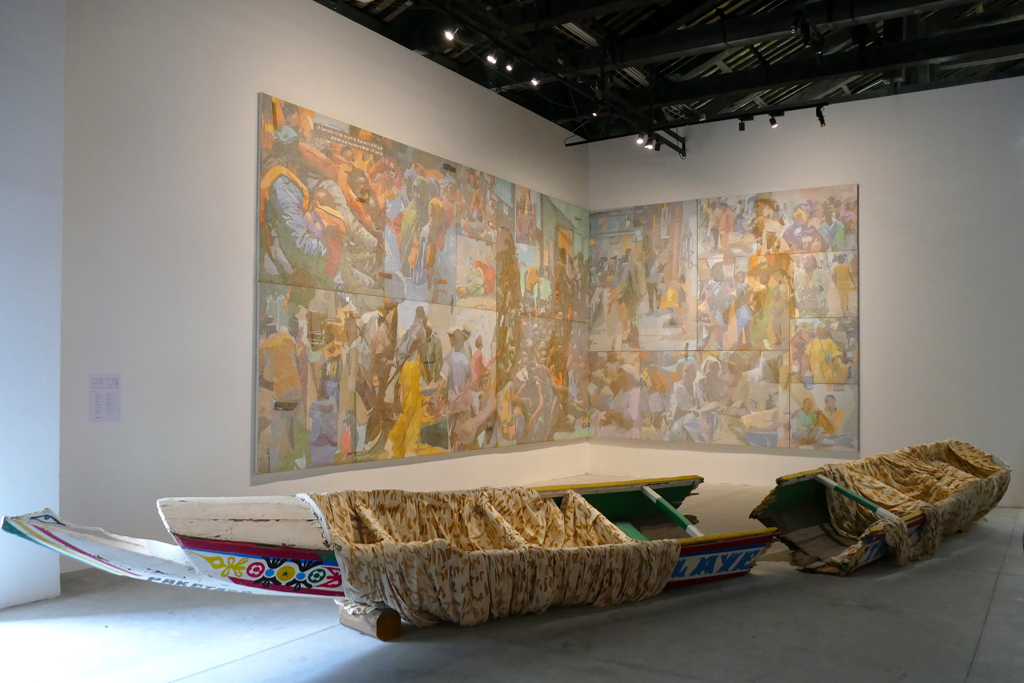
At the center of the installation is a traditional canoe that commemorates the great waves of migration of humanity and gives a foretaste of future waves of migration caused, among other things, by climate change.
Venue: Senegalese Pavilion at the Arsenale
Serbia
Aleksandar Denić: Exposition Coloniale
The Serbian set designer Aleksandar Denić lives in Germany, where he has worked at large theaters and with well-known theater people. Perhaps it is because his installation Exposition Coloniale, with its depiction of consumer goods from the 1960s and 1970s, immediately brings to mind the era of the so-called guest workers, an era in which people from southern Europe came to Germany to work.

There are parts in the room that come from the hard proletarian working world. There are also obviously private areas that the visitor perceives almost like a voyeur. The sophisticated staging allows you to experience the exhibition holistically and with all your senses.
Venue: Serbian Pavilion at the Giardini
Spain
Sandra Gamarra Heshiki: Migrant Art Gallery
I don’t know if it was the Black Lives Matter movement that triggered a rethink among the former colonial nations. Maybe it was just time to name and deal with the bloody past that ensures a prosperous present for many European countries. In museums in the Netherlands and Great Britain, you can now find plaques next to the portraits of supposedly important men, indicating how they achieved wealth and influence. Slave trade or some other type of colonial exploitation was involved more often than not.
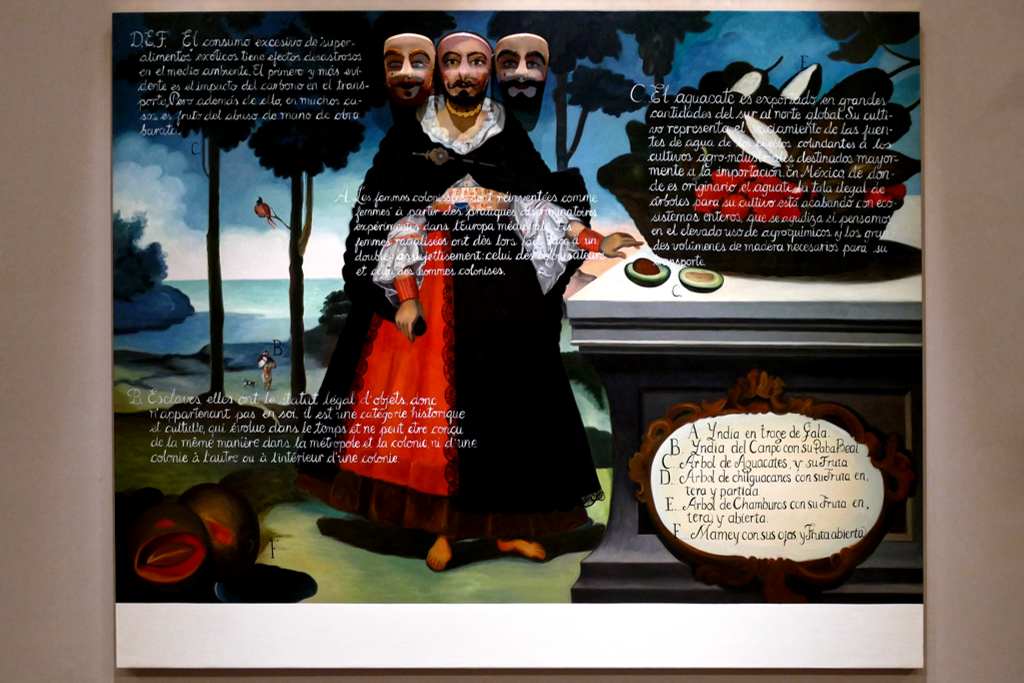
Well, the fact that almost all Central and South American countries have Spanish as their official language probably says it all about Spain’s colonial power. A chapter that has not been dealt with for centuries. It is all the more pleasing that Sandra Gamarra Heshikis deals with the legacy of the colonial period and its effects on different levels.
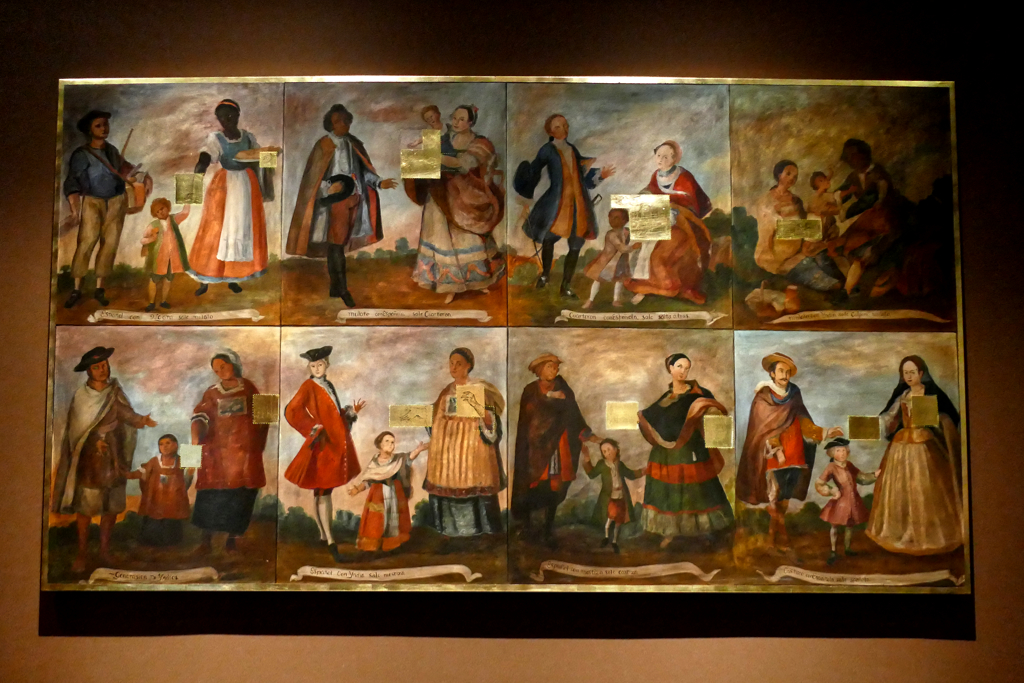
Venue: Spanish Pavilion at the Giardini
Jaume Plensa: Judas
Jaume Plensa’s most famous installation, the Crown Fountain, has stood in Millenium Park in downtown Chicago since 2004. So it is a great honor for this year’s Biennale that the Spanish artist has a mini-exhibition in the Chiesa di San Gallo.
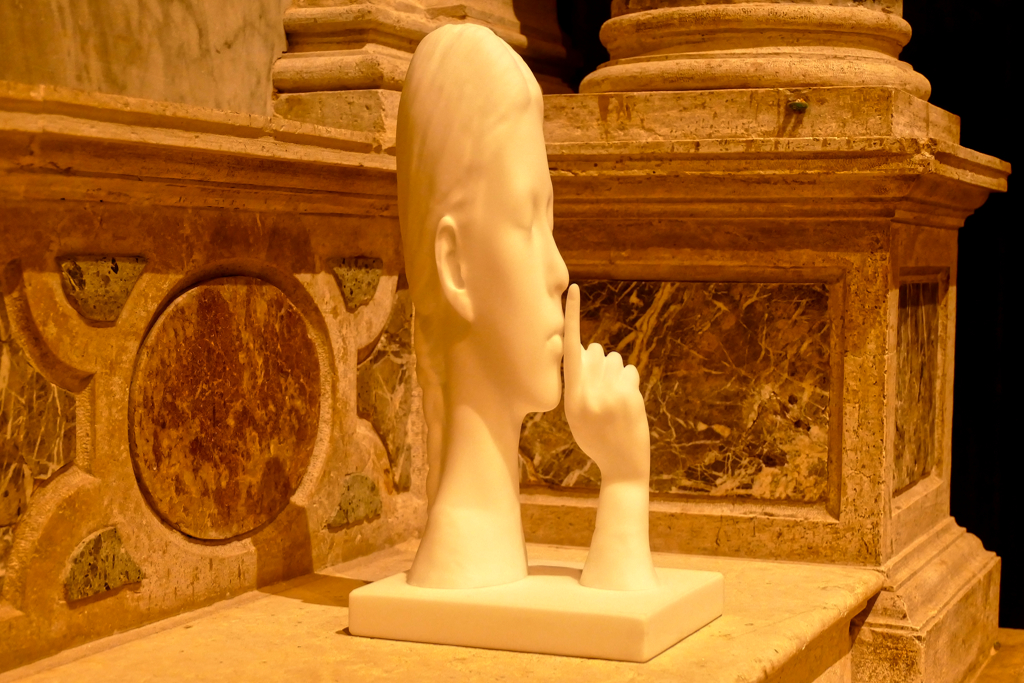
Known for his petrified faces with inward-looking gazes, he implements the duality of the ancient Janus myth in the church in spiritual silence. The exhibition was initiated by none other than jack-of-all-trades Adriano Berengo, who is also responsible for the Glasstress exhibition series. I present this paramount exhibition below.
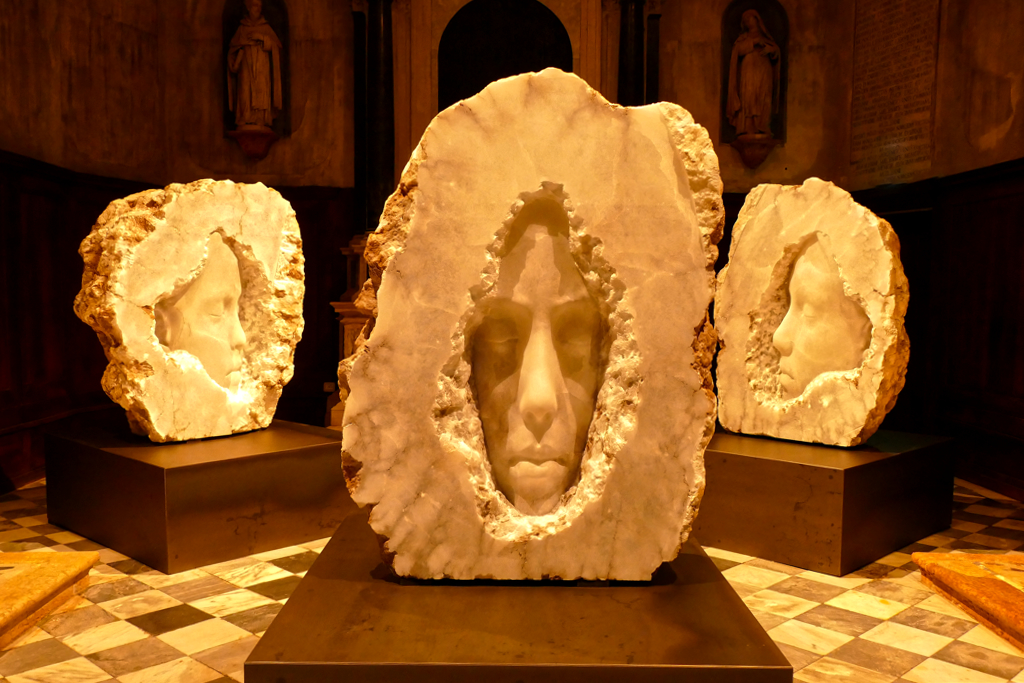
Venue: Chiesa di San Gallo
Manolo Valdés: Las Meninas a San Marco
Thirteen bronze reproductions of Diego Velázquez’s painting Las Meninas stand in single file in St. Mark’s Square. The large-scale installation is the work of Spanish artist Manolo Valdés, who is known for reinterpreting iconic components of art history.
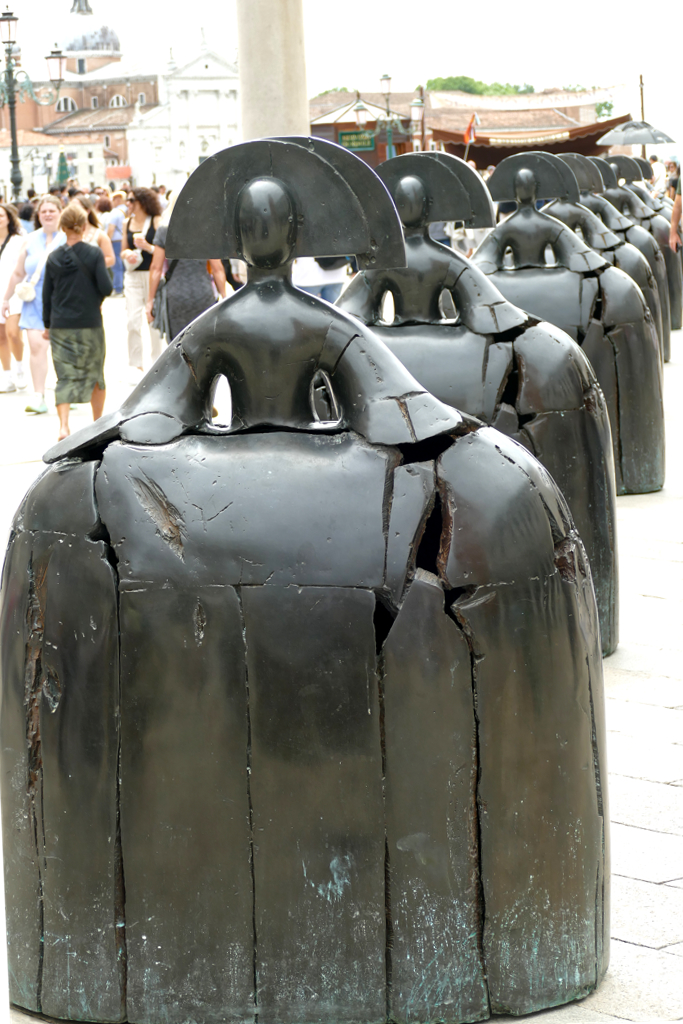
However, Las Meninas a San Marco has come under fire from Italia Nostra-Venezia, an organization that opposes galleries paying for public spaces to display works of art. They fear a biennialization of the city. I totally understand that people are worried about the city deteriorating due to excessive and, above all, mindless over-tourism. But it is questionable whether art activities are what is doing the most damage to the city.
No matter what, the installation was only there until June 15th, anyway. The artist then donated one of the Reina Mariana sculptures to the city.
Switzerland
Guerreiro do Divino Amor: Super Superior Civilizations
This year, the Swiss pavilion is truly exceptionally exciting. In sculptures and, above all, a hilarious video, the Swiss-Brazilian artist Guerreiro do Divino Amor mercilessly pokes fun at Switzerland’s national pride, self-portrayal, and worldwide admiration.
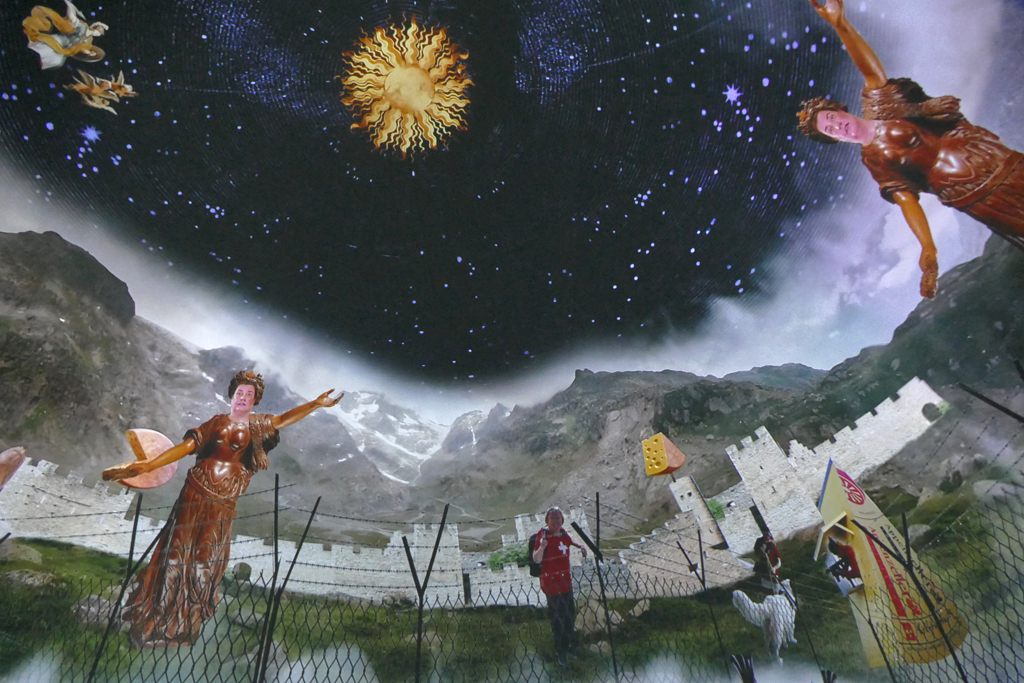
The artist holds up a mirror to Switzerland’s sometimes ridiculous clichés and its much less funny chauvinism.
Venue: Swiss Pavilion at the Giardini
Uganda
Various Artists: Wan Acel | Tuli Bamu | Turibamwe | We Are One
The Uganda Pavilion is somewhat hidden behind the very alluring Campo Bandiera e Moro. What I liked best was the installation by the artist Odur Ronald.
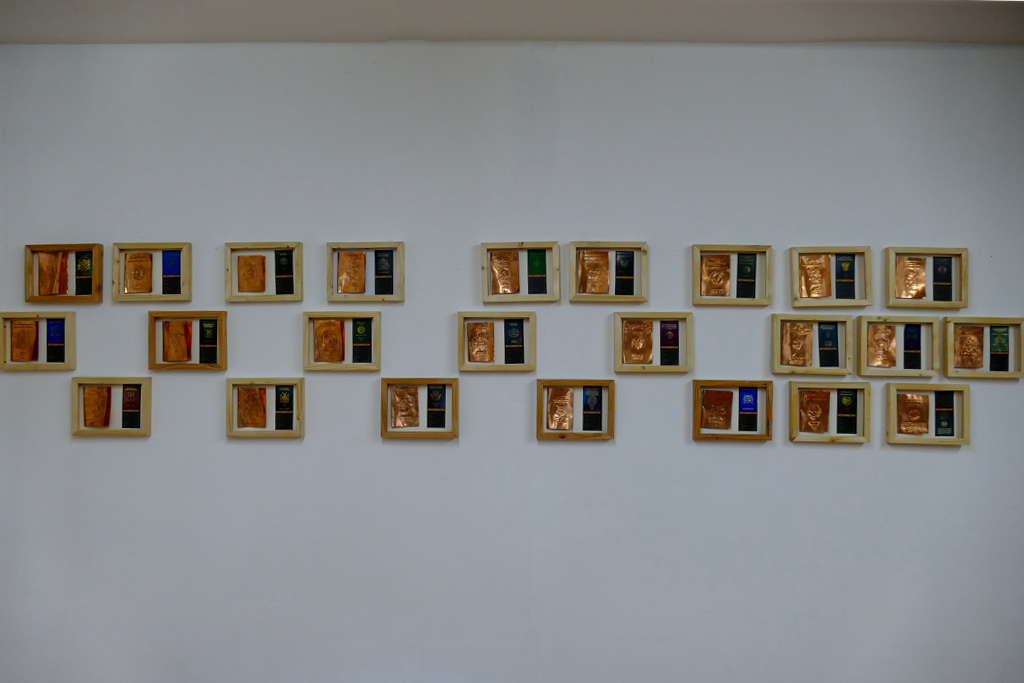
Odur Ronald is a visual artist based in Kampala. Interestingly, he studied interior design. Today he creates installations and sculptures by denting, firing, layering, sewing, painting, and weaving recycled aluminum. And this way, he recreated passports of African countries for the biennale.
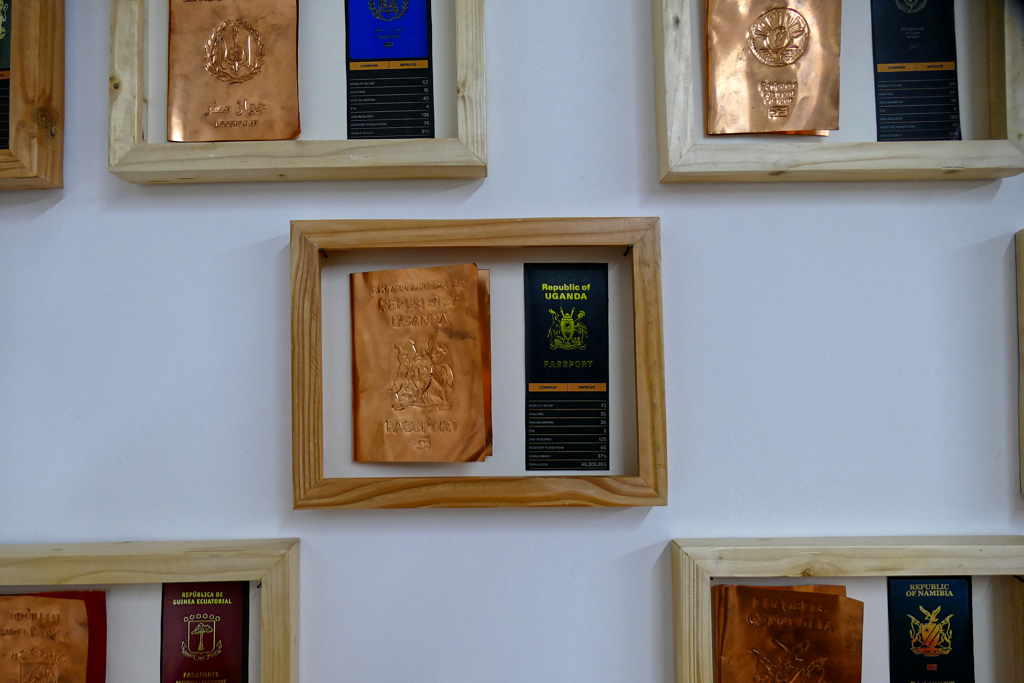
What is more important, however, is what is written next to those documents: There it states how many countries the holder of the passport needs a visa for, how many require a visa on arrival, how many inhabitants the respective country has, and how high – or rather low – the mobility score is. Definitely an insightful contribution to the topic Stranieri Ovunque – Foreigners Everywhere.
Venue: Bragora Gallery, Castello 3496
Ukraine
Various Artists: Net Making
It would be very strange if artists from Ukraine had not dealt with the war in their homeland.
The title Net Making describes an activity in which people come together to weave camouflage nets. Metaphorically, Net Making unites people, obviously.
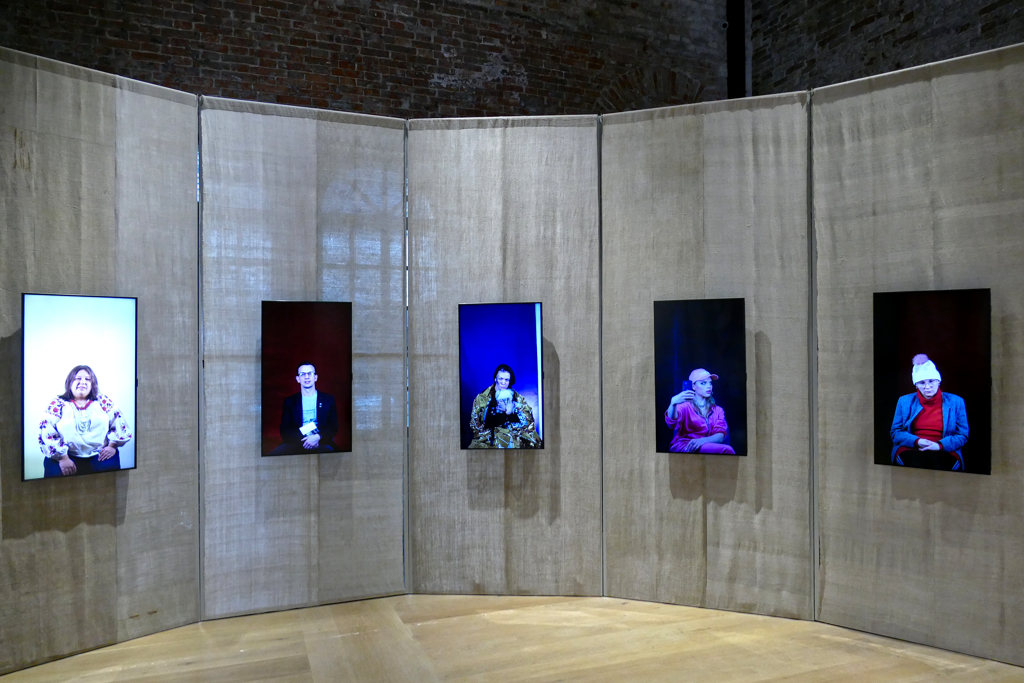
My favorite part, however, is Comfort Work by Andrii Dostliev and Lia Dostlieva. The two artists ironically examine the stereotypes and expectations placed on Ukrainian refugees and have actors portray them in short video sequences.
Venue: Pavilion of Ukraine at the Arsenale
United States Of America
Jeffrey Gibson: The Space in Which to Place Me
Jeffrey Gibson is the first Native American artist to represent his country at the US-American pavilion. And although he clearly draws on the roots of his people in the ornamentation he uses, neither his work nor the artist himself corresponds to the common clichés.

He has created a visual language that combines his indigenous heritage with his queer lifestyle. Descended from the Cherokees, Gibson grew up in large cities in the USA, but also in Germany and Korea.

Through sculptures, mixed media paintings, murals, and a massive outdoor installation, Gibsons showcases his vision of Indigenous art across a wide range of cultures and identities in what is now the United States of America.
Venue: Pavilion of the USA at the Giardini
James Lee Byars: Invisible Questions That Fill the Air
I find it surprising that in the age of Instagram, James Lee Byars doesn’t make much more of a splash with his monumental works. During the biennial of 2017, his mammoth work, the Golden Tower, stood prominently on Campo San Vio. Two years later, at the 58th Biennale, a huge golden wall adorned the Chiesa di Santa Maria della Visitazione as part of the installation The Death of James Lee Byars. Hence, the Golden Boy, who died in Cairo in 1997, is a regular in Venice.
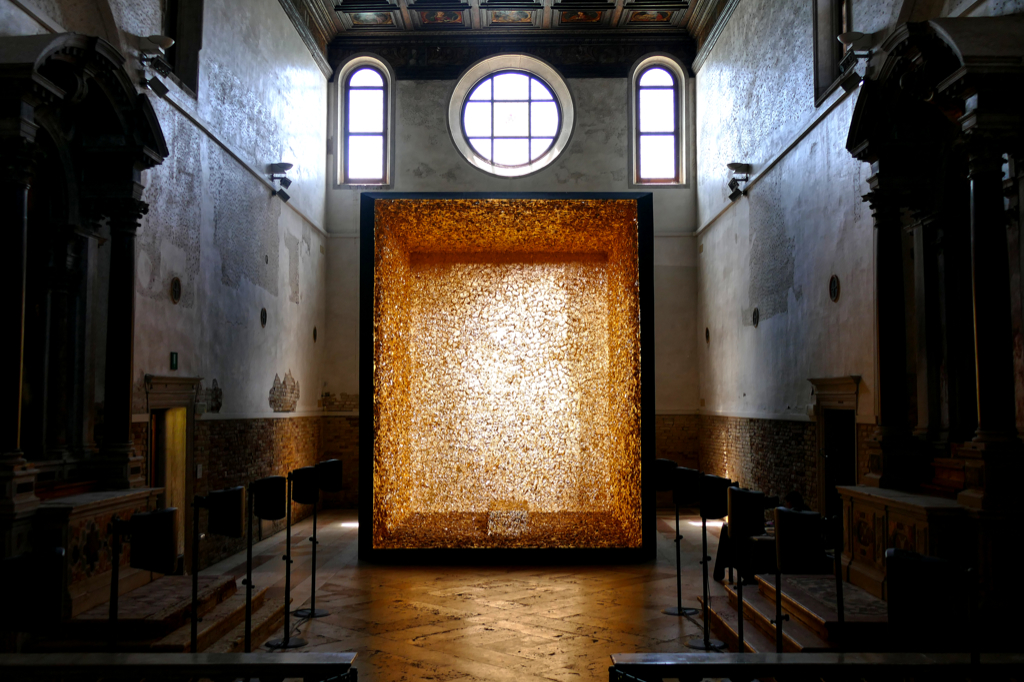
This year, his work is exhibited alongside Seung-Taek Lee’s sculptures at the Palazzo Loredan. The exhibition, curated by Allegra Pesenti, is the continuation of last year’s show at the Michael Werner Gallery in London.
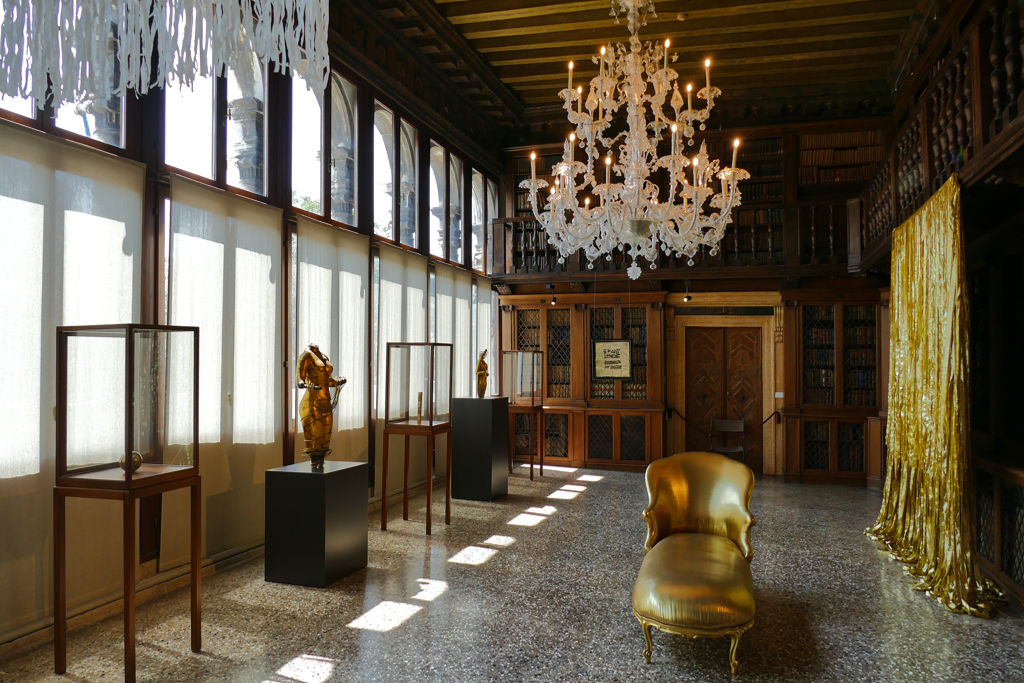
I’ll give you a tip: This palazzo, which houses the Istituto Veneto di Scienze, Lettere ed Arti, is worth a visit just because of the furnishings and the old library. In addition, I have never seen an inconsequential or even bad exhibition here during the biennials.

Since the Istituto’s bookshelves must remain accessible at all times, the works had to be placed accordingly, resulting in an interaction between the art and the space.
Venue: Palazzo Loredan, Campo San Stefano
Uzbekistan
Aziza Kadyri: Don’t Miss the Cue
The Uzbek artist Aziza Kadyri brings together the experiences of Central Asian women as they experience – or reinvent – their identity in the course of migration. The installation combines Uzbek Suzani embroidery and AI image generation. In doing so, she denounces the prejudices of AI and its global influence.

In a deconstructed theater, costumes become sculptures and the viewer simultaneously becomes the observed one.
Venice
Various Artists: Home Sextant
Yes, although there is an Italian pavilion at the Arsenale, Venice has its own pavilion at the Giardini, too. And I cannot remember an edition of the Biennale when the Venetian show wasn’t at least good. Often, it was even spectacular.
This year the exhibition is not spectacular, but it consists of solidly crafted works and is absolutely worth seeing.

The paintings by Safet Zec are particularly outstanding. Zec is a Bosnian artist and graphic designer who fled to Italy in 1992 to escape the Balkan War. Today, he lives and works in Sarajevo, the historic village of Počitelj, Paris, and Venice. I first became aware of Zec in 2017, when his expressive images of escape and misery hung in the church Chiesa della Pietà in Riva degli Schiavoni. In combination with the sacred spaces, the exhibition entitled Exodus was absolutely moving.
So Zec has a history with Venice, hence, it makes perfect sense that he is one of the artists allowed to represent the city at this year’s Biennale.
Venue: Venetian Pavilion at the Giardini
Zimbabwe
Various Artists: Undone
In the Zimbabwe country pavilion, six young artists bring a source of fresh ideas and approaches.

I particularly liked the work of Moffat Takadiwa from Harare. At first glance, they are large traditional shapes and sculptures. When you get closer, you see what they are really made of: waste! He meticulously assembles vast amounts of discarded everyday materials such as bottle caps, toothpaste tubes, toothbrushes, computer keys, and other items into large-format objects.

If you think about it, it’s rather sad that he finds his raw material in such abundance.
Venue: Santa Maria della Pietà, Castello 3701
Glasstress
Mr. Adriano Berengo was born in Venice in 1947. He studied in his hometown at the Ca’ Foscari University in Venice as well as at the State University of New York where he obtained his Ph.D. After a short career as a teacher of English Literature and Language, he started working as the artistic director at the glassworks Vetreria Salviato & C. in 1982. In 1989, Mr. Berengo founded the Berengo Studio to promote glass as an artistic medium.
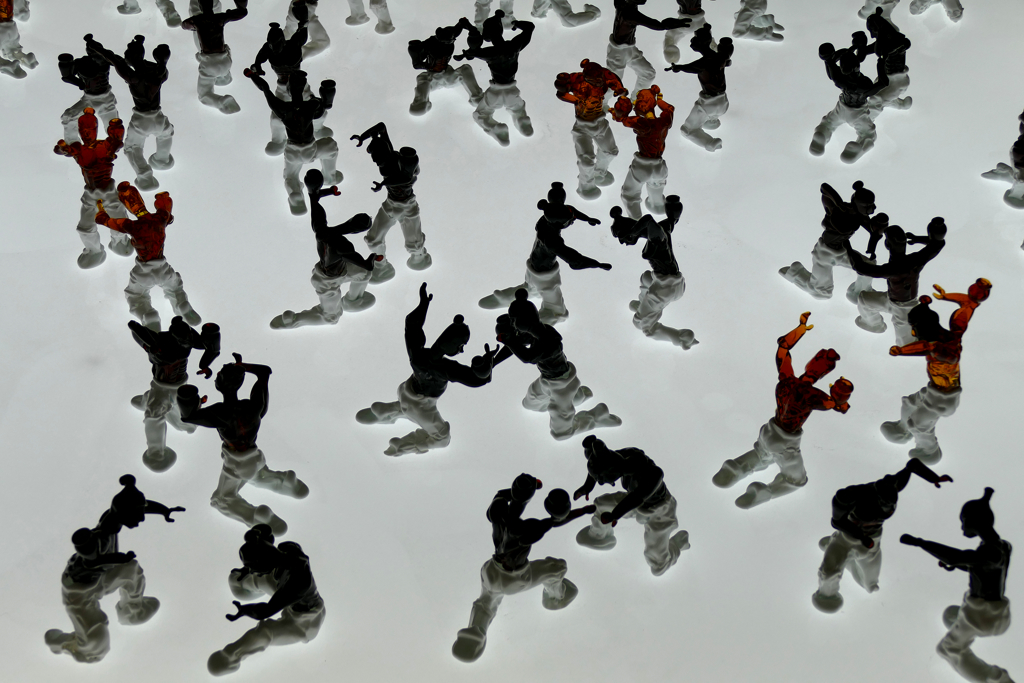
In 2009, the project Glasstress was introduced. It shows the most interesting glass works as a Collaterale during the Biennale di Arte. At that time, the venue of choice was the historical Palazzo Franchetti across from the Accademia right in the heart of the Centro Storico.
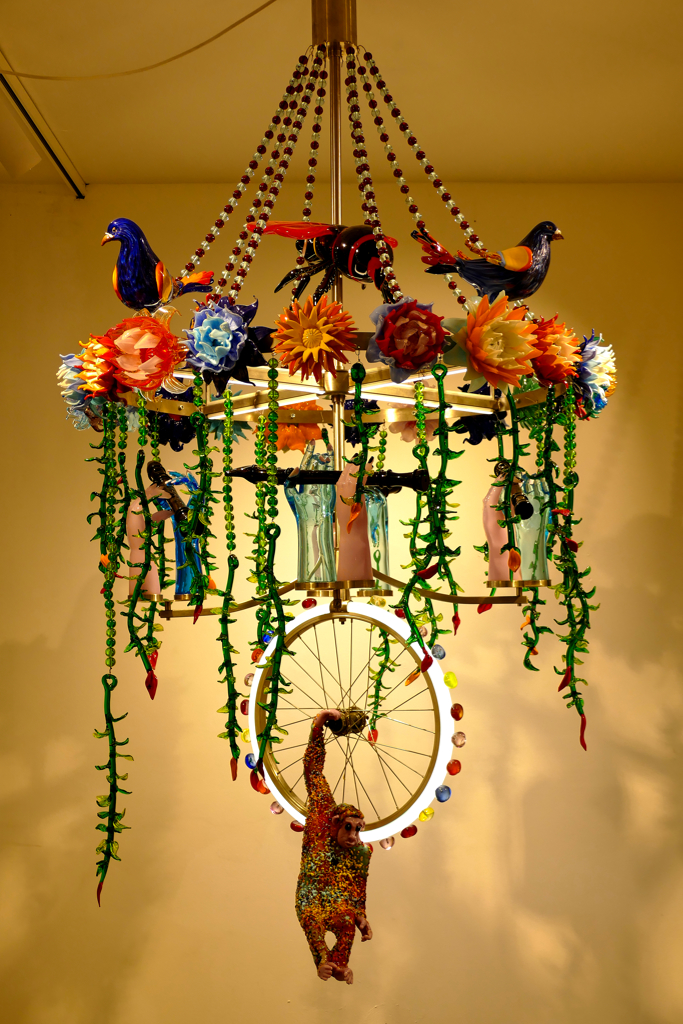

In 2014, Fondazione Berengo was founded. It focuses on Adriano Berengo’s thirty-year project, namely to unite and present the traditional glass art of Murano together with contemporary art projects in a fresh, innovative way.
Expect the Unexpected
When I visited Glasstress in 2013 for the first time, the exhibition just blew me away and left me speechless.
To me, glass, whether used in handicrafts or art, had always been not only a fragile and tender material. I expected the products to be lovely and sweet, pleasant and pleasing.

But what I saw there was totally different from what you’d expect from glass. The works were raw and rough, political, critical, and daring.
It was possible to create this from glass?! Wow!

Glasstress became one of my very favorite shows at the biennials and since then, I haven’t missed a single one.
It never got old or mediocre. On the contrary, with every edition, I was amazed by what artists had contributed. Obviously, those were artists I had never expected to work with glass. I saw works by superstars such as Ai Wei Wei, the Chapmans, Ilya and Emilia Kabakov, and Erwin Wurm.
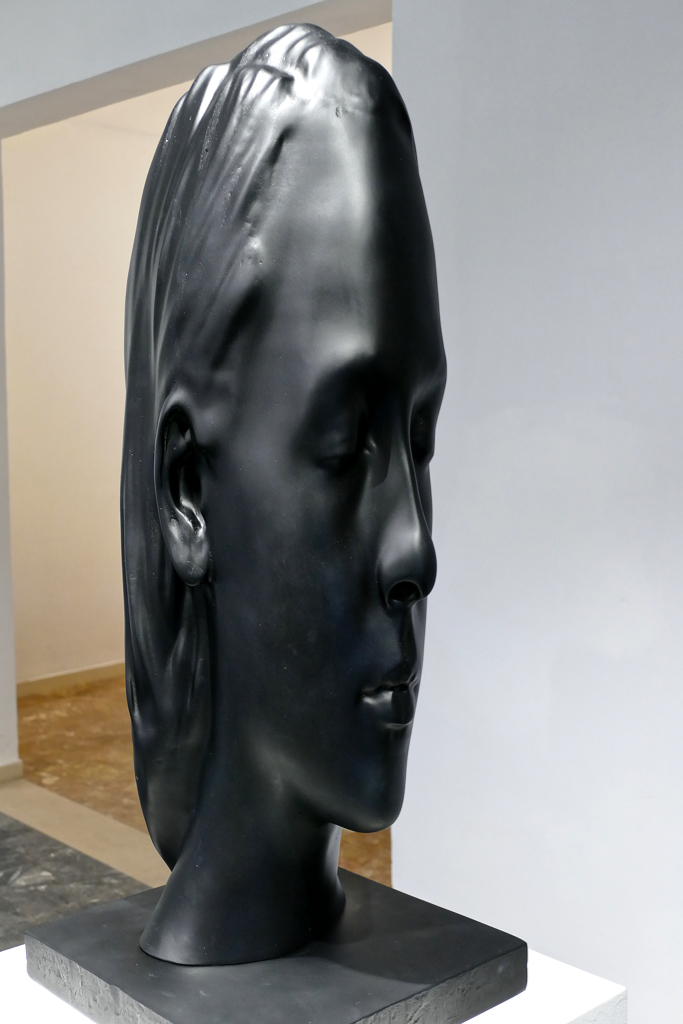
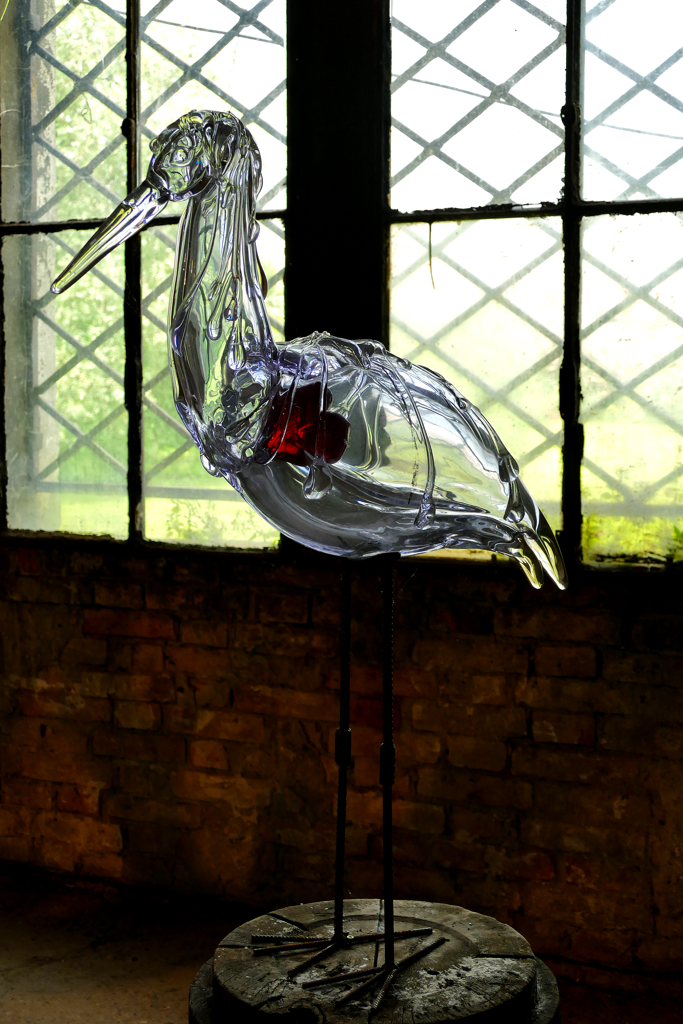
In 2019, to celebrate Glasstress’ 10th anniversary as well as 30 years of Berengo Studio, the exhibition moved from the Palazzo Franchetti to the island of Murano.
It was simply a masterstroke to choose an abandoned glass furnace for presenting this kind of outstanding work and installation. You truly have the impression to witness how these incredible pieces are emerging before your eyes.
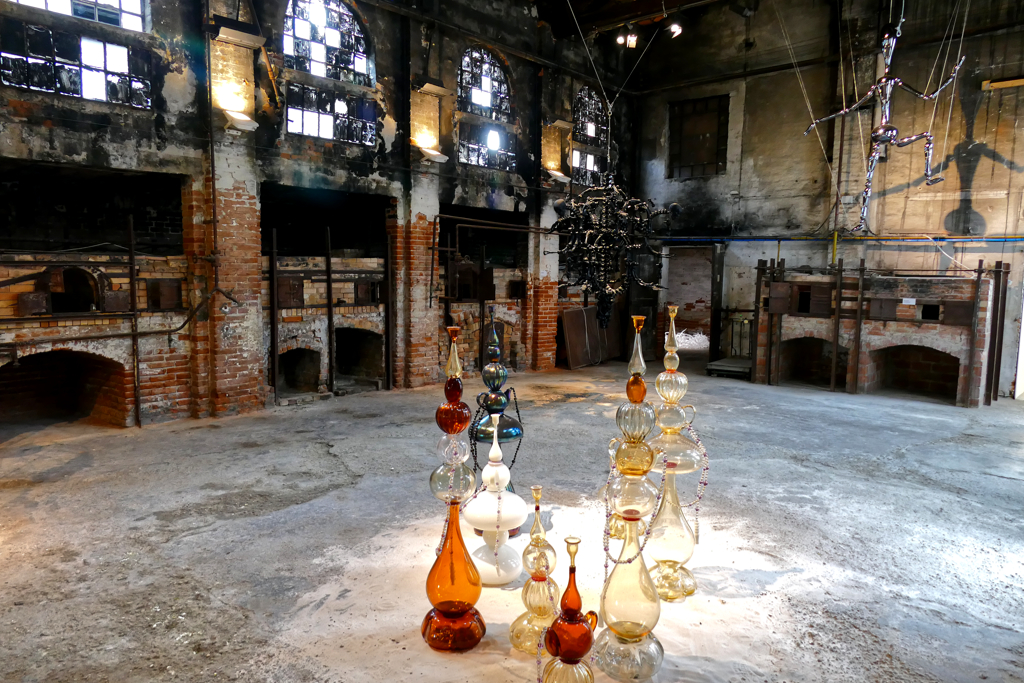
You can visit the Fondazione Berengo Art Space from Tuesday to Sunday between 10 a.m. and 5 p.m. free of charge. You’ll find them a bit hidden in a side alley of the Campiello della Pescheria on the island of Murano.
Plan Your Visit
When to Go
Just like the 59th edition in 2022, this year’s 60th biennial has begun at the end of April. It will last until the end of November 24, 2024.
If you visit during the shoulder seasons, prices for accommodation and many services are still lower than during the high season in summer. Also, during the summer months, it gets really hot, and walking around is rather a drag than fun.
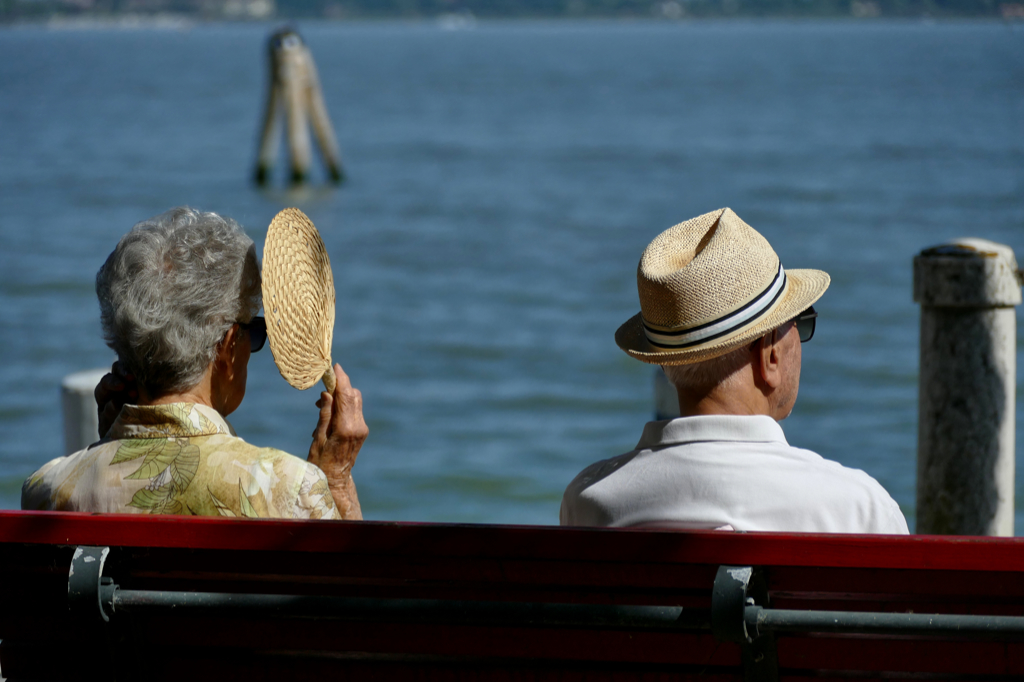
Either way, make sure to check out my post on how to visit Venice on a budget where I supply you with tons of tips on how to visit Venice smoothly and without burning a hole into your wallet.
Tickets
As I wrote above, the Biennale is basically divided into three parts. Firstly, there are the two official venues Arsenale and Giardini. Then, there are the country pavilions scattered all over the city. Finally, you have the so-called Collaterali, major art exhibitions taking place at exclusive venues.
To visit the Arsenale and the Giardini, you need to buy a ticket, obviously. However, there are different kinds of tickets – with or without guided tours and other extras.
This year, a general ticket costs 30 €uros and grants one-time access to both main venues on the same day or on different days that don’t even have to be consecutive. Visitors over 65 pay 20 €uros and students and visitors under the age of 26 pay only 16 €uros.
Then, some passes grant multiple visits: A three-day ticket sets you back 40 €uros and grants access on three consecutive days. You can also obtain a ticket for 7 consecutive days for 50 €uros. For unlimited visits, the full price is 75 €uros. Students and visitors under the age of 26 pay only 45 €uros. However, the last two options are really only for you hardcore culture vultures since let me tell you, there is a lot going on you want to see also outside the Giardini and the Arsenale. According to my experience, it’s enough for your eyes and your brain to visit each venue only once.
I absolutely recommend buying tickets online since there might be rush hours. In that case, you’ll have to stand in line forever. If you prefer to get a ticket on the spot, it is faster at the Giardini than at the Arsenale. At least according to my experience.
Opening Hours
The Giardini and the Arsenale are open from 11 a.m. to 7 p.m. until September. During this period, the Arsenale will be open until 8 p.m. on Fridays and Saturdays. From October, they will be open from 10 a.m. to 6 p.m.
While the two main venues remain closed on Mondays, many of the country pavilions in the center close on Tuesdays. Theoretically. In practice, it happens that you find a note on the door of a pavilion saying it will remain closed for whatever reason. Or you are asked to come back later since there is a problem with the electricity. Or for no apparent reason, a pavilion doesn’t open. Ever, no matter how often you pass by. This can be very frustrating, especially if you’ve searched for that address for hours or even had to take a Vaporetto to another islet. Yet, somehow, it’s part of the charm of the whole thing so don’t get upset and just pick another venue. There is enough other stuff to see, believe me.
Entrance Fees Outside the Main Venues
In general, there is no entrance fee to the country pavilions. Since they are spread across the entire city and beyond, the challenge is rather to find them in the narrow, hidden alleys of Venice. Also, some of them are on Venice’s smaller islands like the Giudecca, Isola di San Servolo, and others.
However, the city pavilions are a very charming part of the Biennale since you have access to buildings that normally are not open to the public. Also, the combination of the old, deteriorating walls and ceilings and the sometimes hyper-modern art is very alluring.
Simultaneously with the main event Biennale di Arte, major art exhibitions are taking place. They either focus on one famous, important artist or a group of artists in a themed exhibition.
Since these so-called Collaterali are often taking place at exclusive art venues such as the Fondazione Prada, the François Pinault Foundation, or the Ca’ Foscari, you need an extra ticket to visit them.
How to Get Around
As you might know, the Centro Storico and most of the smaller islands in the Venetian lagoon are car-free. Therefore, you simply cannot avoid a lot of walking. As a matter of fact, neither can you avoid taking some kind of boat if you want to visit exhibitions on other islets such as the Giudecca or the Isola die San Giorgio Maggiore, to name just two. Also, depending on where you’re based, the walk to and from the main venues can be an exhausting hike, especially after a long day spent walking around galleries.
Venice has the tacky gondolas, and there are very expensive water taxis. However, there is also a very comprehensive net of Vaporetti which are basically water buses.
Tickets and Passes
While at 9.50 €uros, individual tickets are ridiculously expensive, there are travel passes that are actually not that bad. The more days you buy, the cheaper your rides are. Here is a chart on how much you pay for a day pass in 2024:
| 24 hours | 48 hours | 72 hours | 168 hours (7 days) |
| 25 €uros | 35 €uros | 45 €uros | 65 €uros |
Note that a 24-hour ticket can actually be used on two days since the clock starts ticking the moment you validate your ticket and lasts actually 24 hours. With the other tickets, it’s the same, obviously.
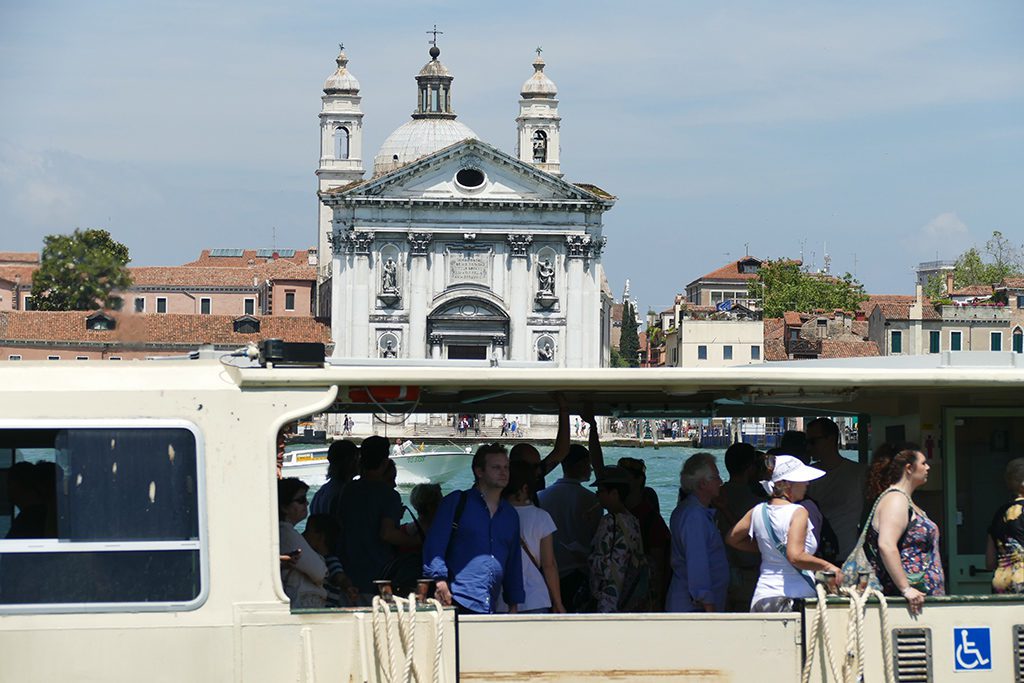
Young people under 29 years of age get an even better deal with the Rolling Venice Card. This title costs 6 €uros and is valid for one whole year. Not only do you get great discounts at many museums and other places of interest. You also pay only 27 €uros for a 72 hours-pass instead of the regular 45 €uros. Unfortunately, you can actually buy only 72 hours-passes. But if you stay for instance for a week, you can get two so that you pay only 54 €uros in total.
Do The Math
Note that there are passes that include trips from and to the Marco Polo Airport. However, keep in mind that as you activate your pass at the airport, the clock starts ticking. It might be cheaper to pay that extra fee for those trips in order to activate your pass later when you need it for your sightseeing.
The passes are also valid in other parts of the Venetian area for instance on the buses on the Lido di Venezia and buses, trains, and the tram in Mestre. All in all, they are a really great deal.

A final note: In the past, basically no one really cared if you paid for your Vaporetto trip or if you just hopped on the ferry and off you went. Yet, this changed dramatically: During my week in Venice this year, I was checked five times! Also, I witnessed how the inspectors could not be talked into anything or charmed. If a passenger did not have a valid ticket, he had to pay 9.50 €uros for the regular fare plus a fine of 50 €uro.
Nevertheless, the inspectors granted them two options: cash or credit card payment.
Also, here’s a little technical tip: If you have a valid ticket and the turnstile still refuses to let you through when you tap, you’ve definitely tapped at the wrong entrance. At busy stations such as Piazzale Roma or Ferrovia, there are actually two entrances: One for tourists and one for residents. When the Vaporetto arrives, the passengers in the resident queue have priority boarding. I think this is a very practical and fair solution since the residents are already so disturbed by the masses of tourists that they should at least have priority when taking the Vaporetto.
So if your perfectly good ticket declines, try the other entrance.
Venice Entrance Fee 2024
Yes, it’s true: In its fight against merciless over-tourism, Venice has installed an entrance fee.
While the visitors are all freaking out and panicking about being thrown into the dungeon forever because they were caught without a valid ticket, the Italians take it rather easy.
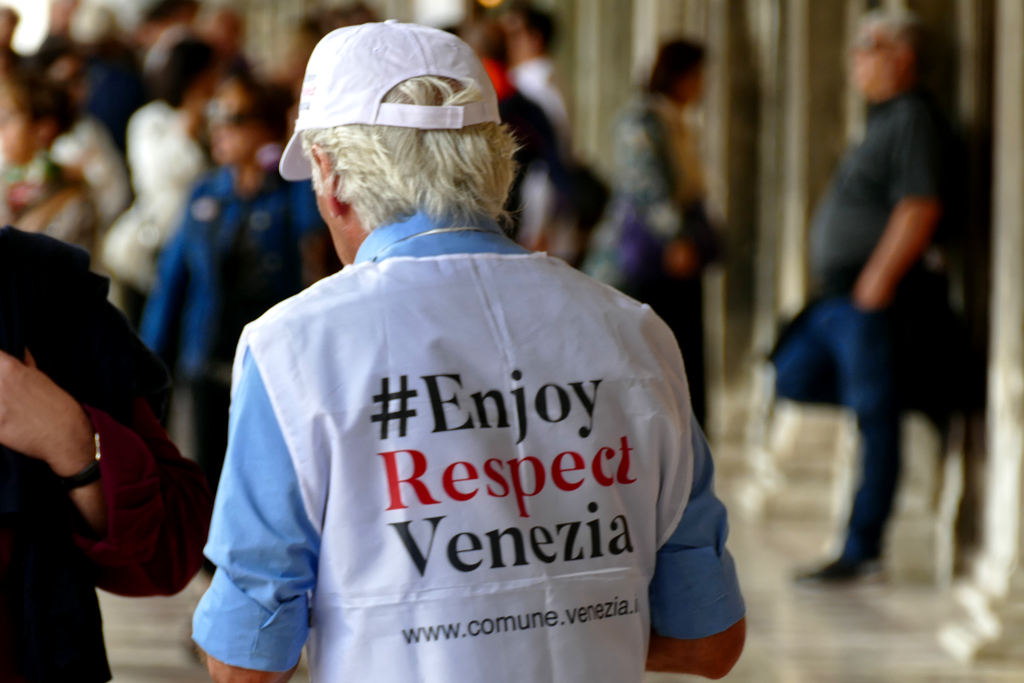
It is a pilot project that has been applied on certain days – mostly weekends – since April. You have to pay 5 €uros online if you are in the Centro Storico on the designated days between 8.30 a.m. and 4 p.m. You don’t have to pay anything if you stay overnight in the greater Venice area – for example in Mestre on the mainland. Neither do you have to pay anything if you’re just on the smaller islands like Murano, Burano, Torcello, and the Lido. You also don’t have to pay if you’re just changing buses in Piazzale Rome or trains at Stazione Santa Lucia.
And who controls all that? In my experience, no one.
However, since the amount is really manageable, I would pay it.
You can get more info on this website, and here, you can pay your dues or obtain an exemption.
Some Extra Tips
After having been to several biennials, I’m happy to share some tips that will make your visit less stressful:
- Walk as little as possible.
Don’t get me wrong, I’m an avid walker. On city breaks, I walk miles and miles. However, you’ll walk those miles even if you try to walk as little as possible. Because don’t expect the Vaporetto to stop right in front of your accommodation. You’ll probably have to cross a couple of bridges to get to your nearest stop.
To get from the end of the Arsenale back to the entrance, it’s about a mile. Will say, even if you go straight from the entrance to the final pavilion and back, you’ll walk two miles. This route does neither include the meandering within the galleries nor detours to bathrooms.
You won’t be exactly lazy even if you avoid walking wherever you can. - Wear comfortable, sturdy shoes
After having explained above how much you’ll automatically have to walk, it should go without further explaining why you have to wear comfortable shoes. It won’t hurt – literally – if you even opt for hiking boots.
Visiting Venice is exercise. Vising the Biennale is boot camp. - Bring some picnic and water
This is actually optional since there are stands and cafeterias at the main venues. However, It won’t surprise you that they are slightly overpriced. As a matter of fact, the prices aren’t even the reason that I don’t like to buy there. The main reason is the long lines. You wait in line at the entrance, you wait at the bathroom – do yourself a favor and avoid waiting in line for a sip of water.
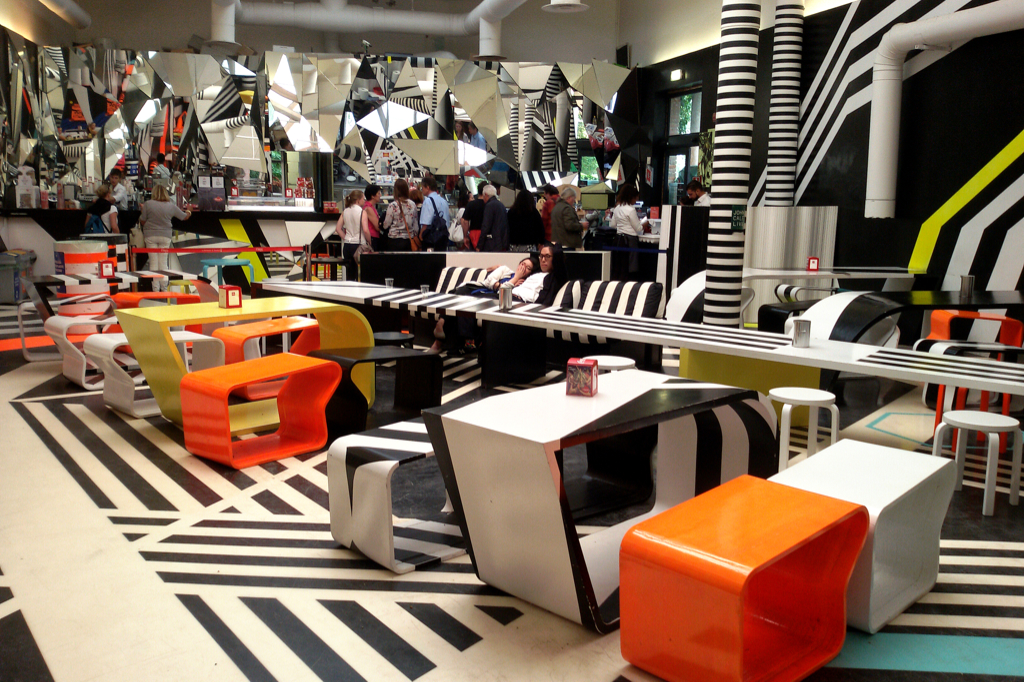
Map
On this map, you get an overview of where all these wonderful works can be found. Clicking on the slider symbol at the top left or the full-screen icon at the top right will display the whole map including the legend. To better identify the respective work, I’ve uploaded pictures that you see as soon as you open the legend.
Pinnable Pictures
If you choose to pin this post, please use one of these pictures:
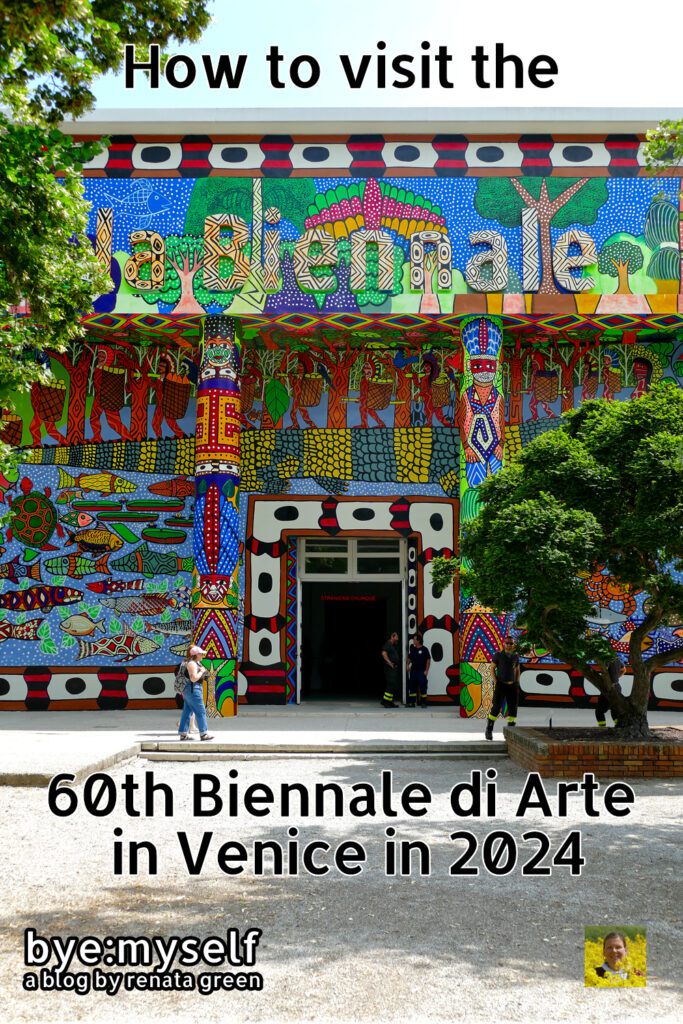

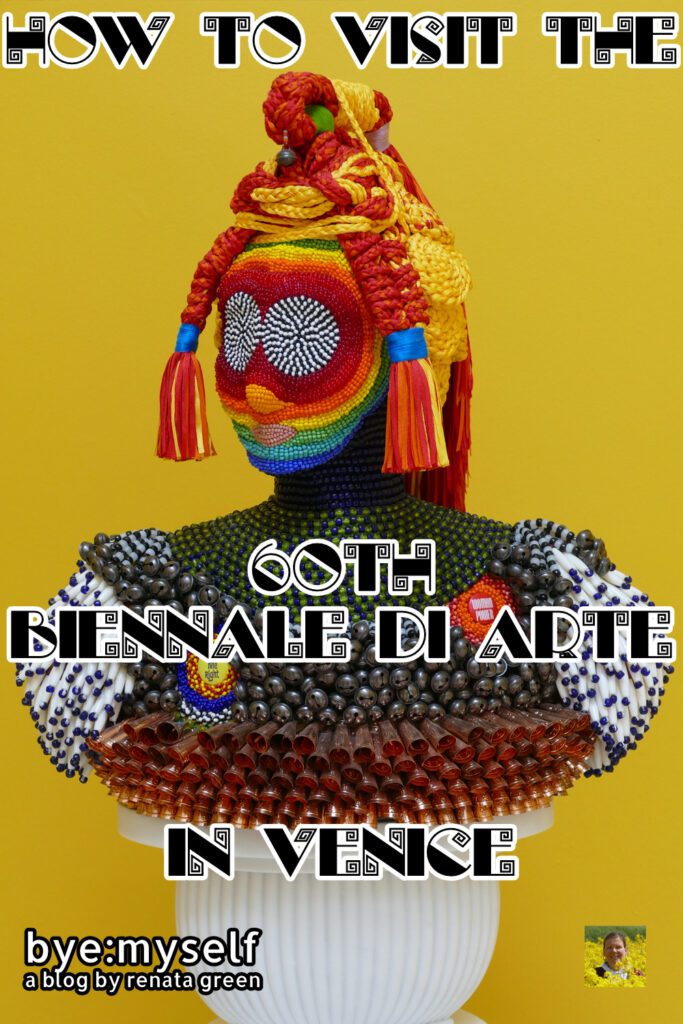
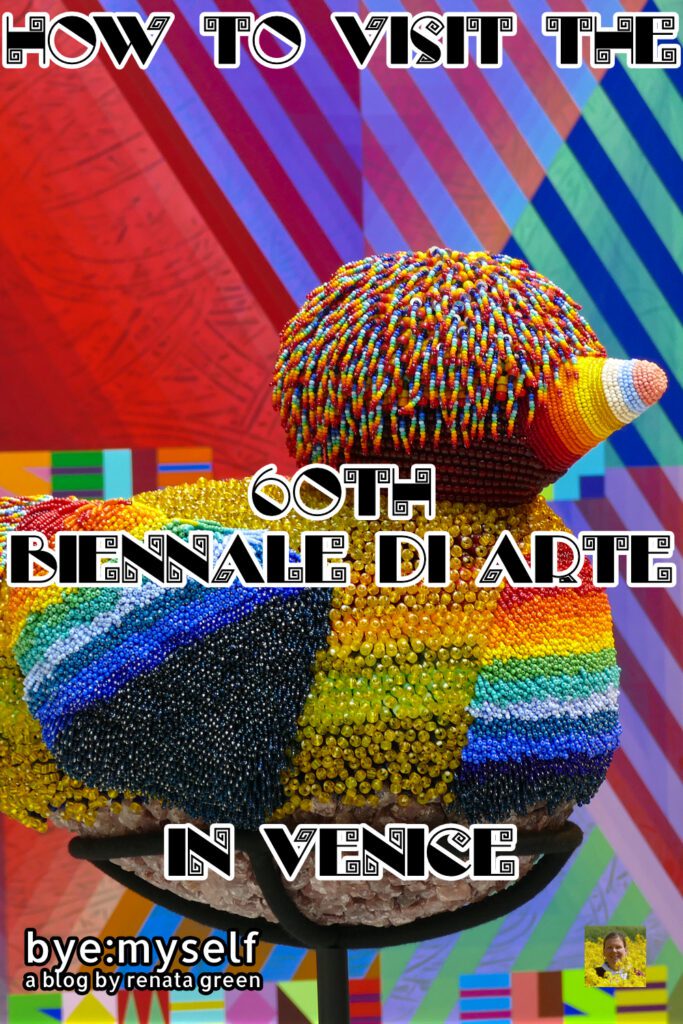
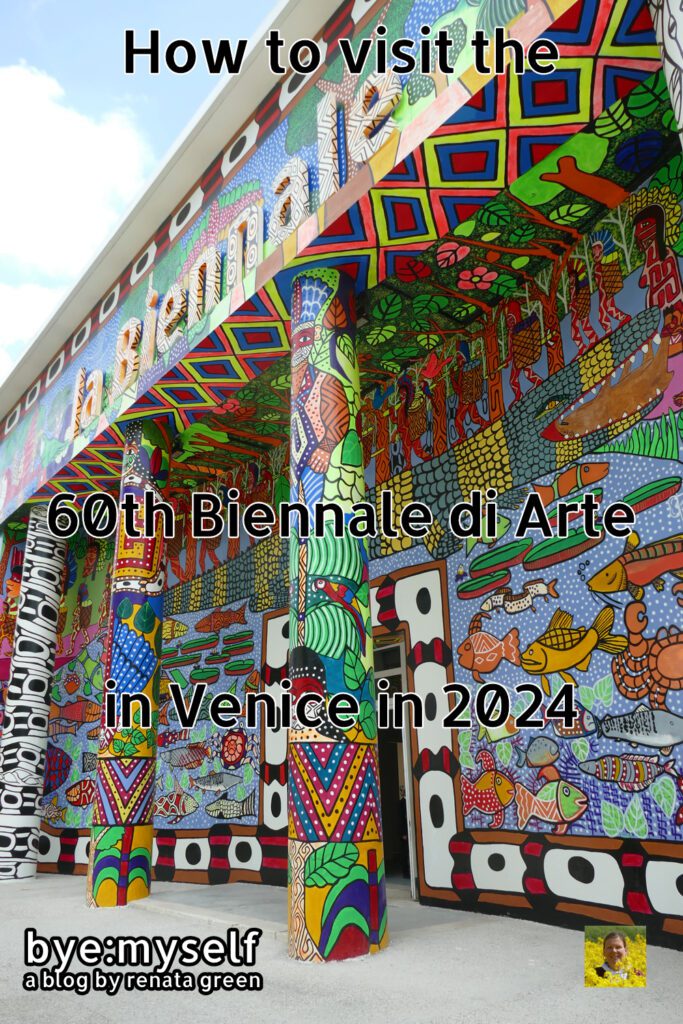
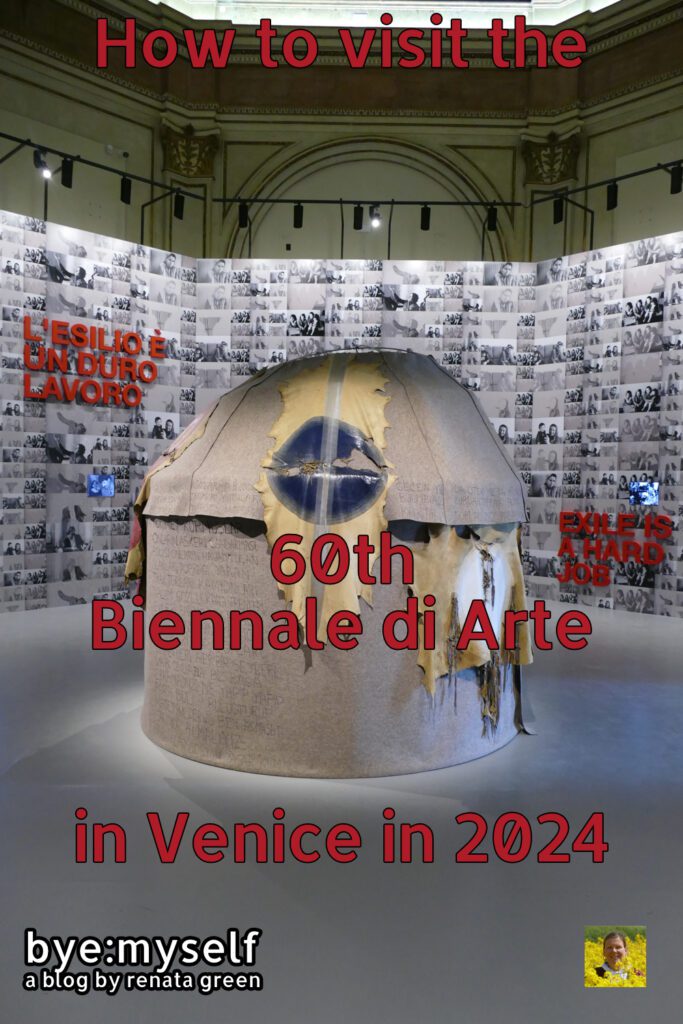
Did You Enjoy This Post? Then You Might Like Also These About More Art And Art Events:
Culture Villages in Korea: Real People, Real Art
BASEL and the Rehberger-Trail – time to wonder, time to wander
Best Street Art in VIENNA
7 Best And Most Beautiful Coffee Houses in Busan
Best Street Art in COPENHAGEN: The Open Air Gable Gallery in Nordvest
A Visit to the Berlin Biennale 2022
The Amazing Murals of the Hotel Ruins of Alyko
Best Street Art in LONDON – Part II: Shoreditch
* This is an affiliate link. If you book through this page, not only do you get the best deal. I also get a small commission that helps me run this blog. Thank you so much for supporting me!

